 |
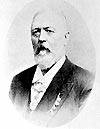 |
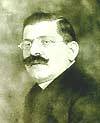 |
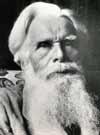 |
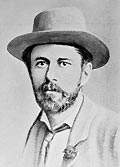 |
 |
| Clockwise, from the top left: Ulrichs (1825–1895), von Krafft-Ebing (1840–1902), Hirschfeld (1868–1935), Moll (1862–1939), Carpenter (1844–1929) and Ellis (1868–1935). [2] | ||
|
|
Electronic Musicological Review |
|||
| Volume VII - December 2002 |
||||
home . about . editors . issues . submissions . em português
Lesbian and Gay Music
by Philip
Brett and Elizabeth
Wood
The unexpurgated full-length original of the New Grove II article, edited by Carlos Palombini. [*]
By permission of Philip Brett, Elizabeth Wood and the newsletter of the Gay and Lesbian Study Group (GLSG Newsletter) of the American Musicological Society (AMS), owners of the copyright.
A record, in both historical
documentation and biographical reclamation, of the struggles and sensibilities
of homosexual people of the West that came out in their music, and of the [undoubted
but unacknowledged] contribution of homosexual men and women to the music profession.
In broader terms, a special perspective from which Western music of all kinds
can be heard and critiqued.
I. Introduction to the original version
What Grove
printed under ‘Gay and Lesbian Music’ was not entirely what we intended,
from the title on. Since we were allotted only two 2500 words and wrote almost
five times as much, we inevitably expected cuts. These came not as we feared
in the more theoretical sections, but in certain other targeted areas: names,
popular music, and the role of women.
Though some living musicians were
allowed in, all those thought to be uncomfortable about their sexual orientation's
being known were excised, beginning with Boulez. We had had enormous difficulty,
in any case, getting the names of any ‘out’ British classical-music
composers from anyone in that country where the closet was born.
Our aim in including a great deal
of popular music was partly political, and partly because it was especially
here that we could acknowledge the amount of work that has been done in the
field. It was a pity, though, that Klaus Nomi got excised in view of his status
in Europe: our editor, Stanley Sadie, viewed our topic as an exclusively (North)
American concern, and did a good deal to enforce that opinion.
There would always have been a danger,
in writing a combined article like this, of an imbalance between the sexes:
we worked hard to eliminate that possibility, but our editor again did not help
us. The change of title, which he would not accept, was a statement of our intent.
He also rejected our attempt to relate the gay and lesbian movement post-Stonewall
and the appearance of lesbian and gay perspectives/studies in music in the 1990s
to political and intellectual contexts and developments. These included the
impact the women's liberation movement of the 1960s had upon lesbian visibility,
feminist debates about sex, sex differences and sexual oppression, the ‘women's
music’ movement and study of women in music and the development of feminist
critique and studies of gender and sexuality.
In either version, though, this article
is an amalgam of the work of a community. The various people who read it, commented
on it, or contributed parts to it were acknowledged in what we submitted, but
that acknowledgement was of course cut. It is restored here with our heartfelt
thanks to those people without whom we could not even have begun.
Though the difficulties with Grove
were substantial, and have been exacerbated by some public rhetoric from the
editor about how impossible we were to deal with, [1]
the opportunity to write abut the entire field (as opposed to the genre-inflected
approach of previous encyclopaedias) was very instructive. The piece we produced
was not intended to close the book on whatever ‘Lesbian and Gay Music’
might be, but to use theoretical speculation and suggestion to open it up. We
hope that anyone reading it will be able to see straight away the possibility
of dozens of dissertation or book topics. And we dedicate it to all those who
have worked, often at considerable professional disadvantage, in this field
that connects our scholarship to our lives in the most fruitful way.
II. (Homo)sexuality and musicality
To think
about sexual categories as being arbitrary, or contingent on historical or social
practice, is still difficult for most people because sexuality, like musicality,
has been so thoroughly naturalized during the 20th century, and intimately embedded
in an individual sense of self (Jagose
1996: 17–18). But, while maintaining the importance for modern society
of the categories of heterosexuality and homosexuality themselves and the process
of acculturation that surrounds them, thinking historically about that ‘sense
of self’ has, paradoxically, become the basis of much lesbian and gay critical
work. It also underwrites ‘queer theory’, the intellectual phenomenon
based on the recuperation of the pejorative term ‘queer’ and the inflecting
of lesbian and gay knowledge with postmodern knowledge and ways of thinking.
Arguing along lines proposed by Foucault, Halperin (1990:
24–25) pinpoints the historical difficulty: ‘homosexuality presupposes
sexuality, and sexuality itself [...] is a modern invention’ which ‘represents
the appropriation of the human body and of its erogenous zones by an
ideological discourse’. Before the beginning of the 19th century deviant
sexual acts such as sodomy — ‘that utterly confused category’ (Foucault
1978: 101) — were not particularized according to gender or even species;
and some ancient modes of same-sex desire, such as Sapphism and pederasty, can
be traced through Western culture. By the end of the century, however, the dominant
model of heterosexuality was posited upon its binary opposition to an actual
(but still incoherent) homosexual identity. A similar process of identity formation
can be seen in music, where ‘musicality’ replaced the earlier and
vaguer ‘musicalness’ as an inherent quality attributed to ‘nature’
but actually constructed in musical institutions of various kinds, particularly
educational ones involved in the development of musical talent (see Kingsbury
1988).
The connection between musicality
and homosexuality, and a strong supposition that the music profession is made
up largely of homosexuals, entered public discourse as an indirect result of
sexology, the scientific work fundamental to the modern understanding of sexuality,
beginning with K. F. Ulrichs's pioneering work on Uranism in the 1860s and expanded
by Richard von Krafft-Ebing, Magnus Hirschfeld, Albert Moll and other German
authorities. English studies around the turn of the century advocating a liberal
attitude towards the ‘invert’ or ‘Urning’ frequently refer
to the German sources. ‘As to music [...] this is certainly the art which
in its subtlety and tenderness — and perhaps in a certain inclination to
indulge in emotion — lies nearest to the Urning nature. There are
few in fact of this nature who have not some gift in the direction of music’
(Carpenter
1908: 111). Havelock Ellis addressed the topic even more arrestingly (‘it
has been extravagantly said that all musicians are inverts’), and quoted
Oppenheim to the effect that ‘the musical disposition is marked by a great
emotional instability, and this instability is a disposition to nervousness’,
concluding that ‘the musician has not been rendered nervous by his music,
but he owes his nervousness (as also, it may be added, his disposition to homosexuality)
to the same disposition to which he owes his musical aptitude’ (Ellis
1915: 295).
 |
 |
 |
 |
 |
 |
| Clockwise, from the top left: Ulrichs (1825–1895), von Krafft-Ebing (1840–1902), Hirschfeld (1868–1935), Moll (1862–1939), Carpenter (1844–1929) and Ellis (1868–1935). [2] | ||
Such beliefs, when juxtaposed with the public scandals in many European countries
and most importantly the trials of Oscar Wilde in 1895, leading to a maximum
prison term of two years' hard labour for the misdemeanour of ‘gross indecency
with another male person’ (under the famous Labouchère amendment to the
Criminal Law Amendment Act of 1885), only exacerbated a climate in which neither
the presence of homosexuals in music nor their contributions to it could be
acknowledged, and in which the experience of social oppression that informs
lesbian and gay lives could not be connected to musicality. Given this background,
any talk of forbidden and illegal sexuality and music was proscribed. ‘You
didn't mention it’, explained the ninety-one year old Virgil Thomson to
his biographer, offering as ultimate explanation ‘of course everybody knew
about the Oscar Wilde case’ (Tommasini
1997: 69). The art of music, the music profession, and musicology in the
20th century have all been shaped by the knowledge and fear of homosexuality.
The need to separate music from homosexuality has driven the crucial belief
that music transcends ordinary life and is autonomous of social effects or expression.
It has also contributed to the resistance toward critical inquiry into the politics
— especially the sexual politics — of music, and into issues related
to sexual diversity such as gender, class, ethnicity and race, religious belief,
and power.
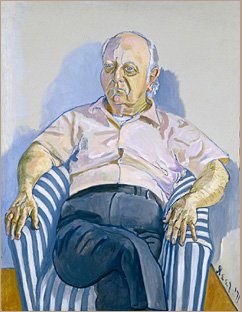 |
| Virgil Thomson (1896–1989): oil on canvas by Alice Neel (1900–1984), 1971, National Portrait Gallery, Smithsonian Institution, (c) Estate of Alice Neel. |
Conversely, the non-specificity of musical language and the doctrine of its
autonomy from social issues led to a special situation in which music played
— and still plays — an important part as both safety valve and regulator
in the mechanism of the ‘closet’, which is not only a symbol of the
hidden nature of many lesbian and gay lives but is arguably the most important
attribute of 20th century homosexuality, more defining and universal in Western
culture than sex acts themselves. In the words of gay author Wayne Koestenbaum
(1993:
189–90), ‘historically, music has been defined as mystery and miasma,
as implicitness rather than explicitness, and so we have hid inside music: in
music we can come out without coming out, we can reveal without saying a word’.
The privilege of freely expressing desire and other feelings in music, a lifeline
to those whose basic emotions are invalidated, appears also to have led to a
concomitant and unspoken agreement to preserve the status quo. Although heavily
populated by lesbians and gays, the various branches of music have been slow
to exhibit any overt opposition to the heteronormative order of things (Brett
in Brett,
Wood and Thomas eds 1994: 16–18).
Most homosexuals internalized their
oppression. ‘Oscar Wilde complained in prison that he had been led astray
by “erotomania” and extravagant sexual appetite; [...] Sir Roger
Casement, the Irish patriot, thought his homosexuality was a terrible disease
which ought to be cured; and Goldsworthy Lowes Dickinson, a liberal humanist
famed for his rationalism, believed his homosexuality to be a misfortune: “I
am like a man crippled”’ (Weeks
1981: 105). Many homosexual musicians combined such internalization of oppression
with some manner of protest, unarticulated though it may have been. The various
mechanisms thus employed are sometimes difficult to decipher, and musicology
has had as yet little experience with their cryptography, but they are arguably
always there. Ravel's ‘conspicuous sublimation’ (Kramer
1995: 203); the high modernist withdrawal of Maxwell Davies; Strayhorn's
self-effacement; Smyth's guarded codes in her operas and memoirs yet exultant
lesbian erotic in her Suffrage music (Wood in Solie
ed. 1993, Wood
1995); Mary Garden's refusal to create the role of Octavian in Der Rosenkavalier
because of its lesbian implications; the social radicalism of Blitzstein and
Tippett; the eccentricity of Vladimir Horowitz and the shrill denials of Peggy
Glanville-Hicks; Britten's pacifism, and his homoerotic discourse under cover
of the musical treatment of canonic literature; Poulenc's musical camp on the
one hand and his religiosity on the other; the insider allusions in the songs
of Cole Porter and Noël Coward; Landowska's fixing on the antediluvian harpsichord
as the vehicle for her virtuosity; Henze's flight from serialism and from Germany;
Kathleen Ferrier's (and many other singers') cultivation of a ‘Sapphonic’
voice (Wood in Brett,
Wood and Thomas eds 1994); the audacity and despair of blues singers such
as Ma Rainey, Bessie Smith and Billie Holiday; Dent's debunking of Beethoven
and other received notions; Szymanowski's involvement with the Dionysian (and
his two-volume homoerotic novel, Ephebos); Copland's early embrace of
eroticism (figured through Orientalism or ‘blackness’) and subsequent
eradication of corporeal or erotic elements in favour of a ‘pure and absolute’
style achieved by means of what Metzer (1997)
calls a ‘compositional scorched-earth campaign’; Virgil Thomson's
collaboration with Gertrude Stein, and his subversive criticism; Partch's ‘hobo’
voices; the falsetto-enhanced ‘lonesome-cowboy’ vocal disguise of
Elton John, and his representation in music at the funeral of Diana, the Outcast
Royal; Cage's dual embrace of both noise and silence within music; Harrison's
gamelan and championing of Esperanto; Menotti's sentimentality; Oliveros's cultivation
of communal ‘deep listening’ and her attachment to the accordion;
Bernstein's over-the-top showmanship; even Boulez's mandarin façade and the
aggressively blank faces of the Pet Shop Boys: all these — or yet other
aspects of the art and self-presentation of these men and women — might
be read as signs of both an accommodation to as well as subversion of the pervasive
fact of the closet.
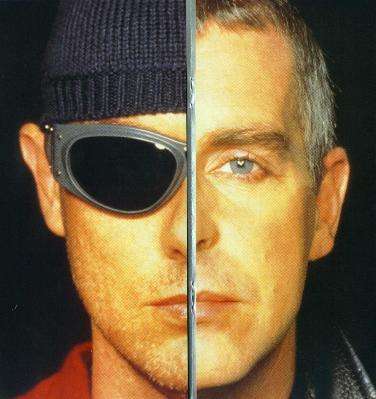 |
| Neil Tennant and Chris Lowe: ‘the aggressively blank faces of the Pet Shop Boys’. [3] |
It will be objected that in many cases a ‘straight’ equivalent may
be found. But a list of this kind, which could be expanded to include Reynaldo
Hahn, Roger Quilter, John Ireland, Charles T. Griffes, Eugene Goosens, Cole
Porter, Dimitri Mitropoulos, Henry Cowell, Noël Coward, Colin McPhee, Wolfgang
Fortner, Samuel Barber, Paul Bowles, David Diamond, Ben Weber, Daniel Pinkham,
Karel Goeyvaerts, Jean Barraqué, Stephen Sondheim, Sylvano Bussotti, Conrad
Susa, David del Tredici, John Corigliano, Charles Wuorinen, Konrad Boehmer,
Thomas Pasatieri and many others, not only shows how very considerable the homosexual
presence has been in 20th century Western music, but also prompts questions
as to how and why, in the post-Freudian age, a basic element of subjectivity
could have been so little examined in relation to music, or why that relation
should have been so obsessively denied — even by a figure like Ned Rorem
who has plentifully advertised his homosexuality in memoirs and diaries. The
fact that homosexual people represent different, sometimes opposing, stylistic
and ideological positions, no matter what part of the music business they are
involved in, argues against a unified ‘homosexual sensibility’ in
music and against any simple relation between sexual identity and musical expression.
It does not support the view that there is no connection between the two.
Enabling the weird dissociation of
homosexuality and music, in spite of their being so patently intertwined for
an entire century, is the mechanism described as the ‘open secret’.
Its function ‘is not to conceal knowledge, so much as to conceal the knowledge
of the knowledge’ (Miller
1988: 206). Its effect is to strengthen the binary oppositions (public/private,
inside/outside, heterosexuality/homosexuality) and to consign homosexuality
to the private sphere, always on the verge of visibility, and therefore always
under surveillance as an unthinkable alternative. To the extent that music,
as a performance art, must occupy the public sphere, with, as it were, all its
secrets on display, then what Miller calls a ‘fantasmatic recovery’
of enormous proportions has to be mounted to keep those secrets from making
any difference. To what degree resistance can be effective in such a situation
is a matter of considerable debate in queer theory. Some incline to what Alan
Sinfield (1994:
21–27) terms the entrapment model, derived from Althusser and various interpretations
of Foucault, in which subversion merely contributes to containment or to a general
postmodernist notion of the subject as completely determined by ideology and
therefore without agency. Theories developed from Gramsci, Raymond Williams
and Zizek, on the other hand, offer more possibilities of effective resistance
by refusing to accept a totalizing system and by recognizing that any ‘dominant
ideology’ is itself constantly undergoing diverse internal disturbances
which dissidence may turn to its advantage in particular historical situations.
‘Coming out’ has been the most undeniably effective political action
since the 1970s. Earlier times demanded different tactics. One of the most effective
of these, retaining a certain power to the present, is ‘camp’, a disruptive
style of humour that defies canons of taste and by its very nature evades any
stable definition. Other solutions existed for those who refused this self-marking
performative style. Britten, for instance, was arguably better advised in exploiting
the open secret and capitalizing on his success in order to ensure wide circulation
of the powerful critiques of the family, heterosexual relations, organized religion,
patriarchal authority, militarism and the rest contained in his works.
Gender, purposely ignored in the
list above, adds layers of complexity to the social situation of homosexuals
in almost all musical contexts in the West, as do race and ethnicity and class.
The male homosexual has been in a particularly ambiguous position in most Western
contexts because, especially if white, he had the option of exerting male privilege
and power, providing he was not publicly exposed. Some who adopted that expedient
behaved in particularly oppressive or offensive ways toward others, for they
often overcompensated in elaborating their disguise. Lesbians, on the other
hand, were treated as a minority not only because of their sexuality but also,
in most musical contexts, because of a hierarchical gender system that pressured
all women into certain roles, such as diva, harpist, pianist, castigated them
for transgressing them, and put severe obstacles in their paths toward others,
such as composer, conductor, saxophone player, impresario.
This system (by no means extinct)
was exacerbated to an unusual degree in the concert and recital hall context
by the emphasis in the Romantic era on the enduring artwork of ‘absolute
music’ and therefore on its creator, who became arguably more powerful,
in spite of the reaction against Romanticism, as a result of high modernism's
war on the non-subservient virtuoso performer (see ‘Women and Music’
and ‘Feminism’). Male and female homosexuals, therefore, have had
very different experiences in various music worlds, but the basis for their
common interest is the codification and regulation of gender roles with appropriate
sexual positions and identities. The assignment of the male homosexual to a
feminine position — the only position dominant ideology will allow him
as a ‘failed man’ — is mirrored, though not exactly, by the mockery
aimed at a challenging or creative lesbian whose work is constantly labelled
‘virile’, ‘manly’, and ‘unnatural’, or ‘deficient
in the feminine charm that might have been expected of a woman composer’,
as demonstrated in turn-of-the-century critical responses to the music of Ethel
Smyth and Rosalind Ellicott (Kertesz
1995, Fuller
1994). That similar criticism was directed at that icon of womanly respectability,
Mrs. H. H. A. Beach, when she wrote a powerful mass or symphony (the composer
George Chadwick called her ‘one of the boys’), indicates the linked
and overlapping forms of gynophobia (fear of women) and homophobia (fear of
homosexuals), as in the ‘masculine protest’ of Charles Ives (Solomon
1987, Tick in Solie
ed. 1993, Kramer
1995: 183–88).
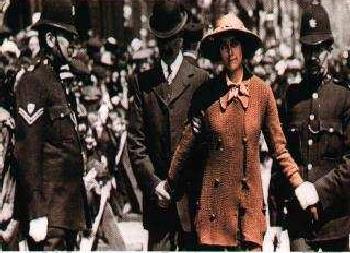 |
| ‘General's daughter among suffragettes arrested outside Downing Street’: from 1910 to 1912 Ethel Smyth (1858–1944) participated in — not always pacific — demonstrations for women's right to vote. [4] |
Ives mirrors threatened masculinity in general, which tends to see all musicians and their activities, whatever their genders or sexualities, as feminine and to value (or devalue) them accordingly. Since people in music all share to some extent the taint of the effeminate or feminized, powerful institutional forces had to be mobilized to counteract that image, especially with the entry of music into the universities on a large scale after World War II. The widespread adoption of a neo-serialist technique, the development of arcane forms of music analysis, the separation of a high art from any form of popular cultural expression, and the equation of musical scholarship with scientific inquiry are all signs of a dominant masculinist, highly rational, heteronormative discourse in music all too unhappily but accurately characterized by the word ‘discipline’.
III. Music and the lesbian and gay movement
In the
wake of the 1950s civil rights movement, which began to change the status of
African-Americans in the USA, various New Left counter-discourses arose, including
a reinvigorated feminist movement for women's rights. A militant lesbian and
gay movement, fomenting on both coasts of the USA after World War II, was catalyzed
by the Stonewall riot in 1969, named after a New York gay bar whose patrons,
mostly working-class men and drag queens (some of them Puerto Rican and black),
fought a pitched battle with police on a routine raid of the premises. The movement
borrowed from the struggle of oppressed racial minorities, devised its own tactics
(the ‘zap’), and linked its theory to both the sexual freedom movement
and to the new oppression theories of feminism. Conflict and subsequent accommodation
between lesbian activists and straight feminists surfaced in the late 1970s
over a U.S. constitutional Equal Rights Amendment and within NOW (National Organization
for Women), and in debates during the early 1980s over lesbian identity, women's
sexual silences and practices, abortion, pornography, and rape. Defining texts
in this area are Adrienne Rich's ‘Compulsory Heterosexuality and Lesbian
Existence’ and Gayle S. Rubin's ‘Thinking Sex: Notes for a Radical
Theory of the Politics of Sexuality’ (both in Abelove,
Barale and Halperin eds 1993). Consensus grew among the various counter-discourses
that unless a sexual revolution was incorporated into a political revolution
there could be no real transformation of society and social relations. Alliances
were also built that led not only to the inclusion of lesbian, gay, bisexual,
transgender, and transsexual concerns under one umbrella but also, somewhat
later, to the involvement of the sexual minorities with the politics of race
and class.
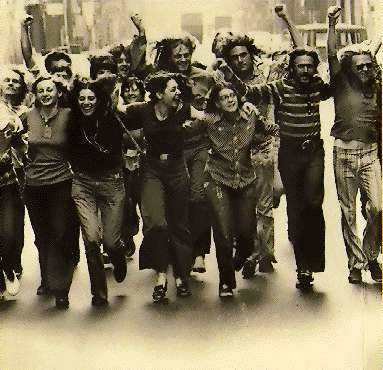 |
| Photograph on a seventies Gay Liberation Front poster. [5] |
The subsequent global spread of the movement was complemented by initiatives
in humanistic scholarship, consisting (as with feminism) of both a historical
branch designed to uncover those ‘hidden from history’ and a theoretical
branch concerned with the pertinent questions of sexual identity and subjectivity
and their relation to capitalist society, although the two often overlapped,
especially on vexed questions of difference in sexual practices and categories
among and between gay men, lesbians, bisexuals, intersex and transgendered people,
both crossculturally and in specific historical moments. This scholarly initiative
has given rise to a situation in which, in Domna C. Stanton's overview (1992:1–46),
modern sexuality is both ‘the most meaning intensive of human activities’
(Eve Sedgwick) and ‘a sign, symbol, or reflection of nearly everything
in our culture’ (Stephen Jay Gould) as well as ‘the name that can
be given to a historical construct’ (Michel Foucault) of social and sexual
relations whose contents and meanings are in constant change and flux.
From the start, homosexual identity
was seen as contingent: ‘our homosexuality is a crucial part of our identity,
not because of anything intrinsic about it but because social oppression made
it so’ (Altman
1971: 230, 1993:
240). Questions about identity persisted, however, for a variety of reasons:
identity categories were seen by many as instruments of the homophobic and heterosexist
order they sought to oppose; they tended to efface ‘hyphenations’
in identities as white people's domination of the movement came under fire;
and they were thrown into disorder by the onset of the decentred, split subject
of postmodern thought.
Accordingly, emphasis moved from
identity toward representation. Some sense of this can be gained from Morrissey's
self-presentation as ‘a prophet of the fourth gender’, punning on
19th century sexology's ‘third gender’ while refusing to be determined
by it (Hubbs
1996). Attempting to establish self-determination in the feminist subject,
Sue-Ellen Case suggested that the role-playing of working-class lesbian bar
culture could be rehabilitated as a ‘combo butch-femme subject’ (reminiscent
of Monique Wittig's ‘j/e’ but ‘replacing the Lacanian slash with
a lesbian bar’) that seduces the sign system with artifice and camp rather
than internalizing the torments of dominant ideology (Case in Abelove,
Barale and Halperin eds 1993: 294–306, for a musical application see
Peraino
1992). Music, especially popular music, often seems to respond in its playful,
coy or disruptive tactics around the vocal as well as visual representation
of sex and gender (consider Madonna, Prince or Boy George) to Judith Butler's
notion of these supposedly natural characteristics as ‘performative’
utterances (i.e. like speech-acts) to which subjects submit in a constrained
repetition as part of entry into language and society. Butler proposes the notable
inversion in which ‘if a regime of sexuality mandates a compulsory performance
of sex, then it may be only through that performance that the binary system
of gender and the binary system of sex come to have intelligibility at all’
(Butler in Abelove,
Barale and Halperin eds 1993: 307–20, for a musical explication see
Cusick in Barkin
and Hamessley eds 1998).
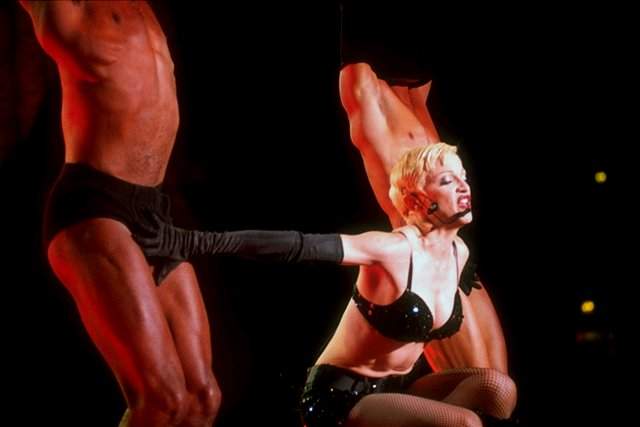 |
| One of Madonna's ‘performative utterances’ in the Girlie Show tournée in 1993. [6] |
In academic music study the excavation of lesbian and gay musics, the critique
of heteronormative assumptions in such areas as music theory, and an exploration
of music and subjectivity might also have begun in the 1970s. But the hermetic
nature of postwar musicological discourse, and the policing of music that led
many to acquiesce to the status quo, hindered the process, as it also hindered
feminist inquiry in musicology and the acceptance of women composers into the
concert hall repertory and in opera. This policing, sometimes overt, as in the
imprisonment of Henry Cowell (Hicks
1991), but more often silent and insidious, is symbolic of a wider, often
unacknowledged, pressure manifest for instance in the recourse of women to work
outside the system. Sometimes the policing was more hushed than silent, as in
the ‘purges of homosexuals’ that David Diamond alleges took place
during Howard Hanson's forty-year directorship of the Eastman School of Music
(Schwarz
1994). Usually, and most devastatingly, it became self-policing.
Avenues for protest did of course
exist or could be created, as left-wing radicals such as Woody Guthrie demonstrated
through a revivified folksong movement in the 1960s. During the 1970s lesbian
and gay musicians began to find the means to give their sexuality musical expression
in various interesting ways, often by a radical reinterpretation of an existing
musical genre or institution. Concert music and its scholarship were virtually
impermeable at this stage because of the venues, conventions, and institutions
governing its performance and the aseptic ideological pressure of high modernism.
Even opera, with its enormous lesbian and gay following (and open invitation
to ridicule), was less susceptible than ballet to queer subversion: La Gran
Scena Opera Company (founded in 1981) never became as successful as its older
sister, the virtuoso drag ballet company Les Ballets Trockaderos de Monte Carlo
(founded in 1974). On the other hand, the entire opera world (and to some extent
that of musical comedy and other music-theatre genres) had long been a stage
on which gays and lesbians could perform, or see performed, our presence and
humanity. Impresarios, managers, producers, critics, librettists, and composers
contributed to this atmosphere along with singers, characters and roles. ‘Where
else’, as Margaret Reynolds asks (in Blackmer
and Smith eds 1995: 133) ‘can you see two women making love in a public
place?’ Such coupling runs the gamut, moreover, from the ‘principal
boy’ of lower-class British pantomime, with her fishnet stockings and full-hipped
swagger, to the aristocratic Octavian playing butch to the Marschallin's femme
in a fin-de-siècle Viennese bedroom, which has often been received as, and was
probably intended to encompass, a symbolic performance of lesbian desire (Mary
Garden's refused to ‘out’ herself by creating the role); and the potential
for such interpretation grew when high modern performance dogma, putting original
tessitura before modern gender sensibility, thrust full-throated mezzos and
sopranos into castrato roles. Historical female couplings without cross-dressing,
too, can take on fresh significance as a result of being exposed to a marginal
perspective, like Dido and the Sorceress in Judith Peraino's account of Purcell's
opera (in Blackmer
and Smith eds 1995). Closet dramas or parables abound: Szymanowski's King
Roger; Henze's The Bassarids; Britten's Albert Herring, Owen
Wingrave, and Death in Venice. Britten's Peter Grimes is a powerful
allegory of homosexual oppression (Brett
1977, 1983)
along lines suggested already by operas, such as Janácek's Kát'a Kabanová
and (more especially) Shostakovitch's Lady Macbeth of the Mtensk District,
that explore the oppression of women. ‘Real’ lesbian or gay characters
are of course harder to find. Mel and Dov, the interracial couple in Tippett's
The Knot Garden (1970) appear to be opera's first ‘out’ gay
males; predictably, they break up, one of them returning to a heterosexual lifestyle.
Countess Geschwitz, the one heroic and truly loving character of Berg's Lulu,
stands as a shining example of musico-dramaturgy that manages to transcend essentialism
and stereotyping (see Morris in Blackmer
and Smith eds 1995).
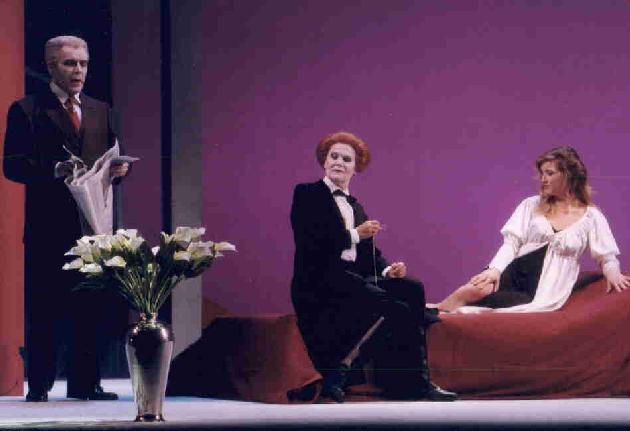 |
| Anja Silja, in the middle, plays the Countess Geschwitz in the Düsseldorf Opera staging of Berg's Lulu in 2000, photograph by Eduard Straub. |
A remarkable phenomenon of the immediately post-Stonewall period was the emergence
of lesbian-feminist or ‘women-identified’ singer-songwriters, bands,
choruses, record labels and production companies (Olivia and Redwood were both
founded in 1973). Venues such as women's coffeehouses and women-only music festivals
also arose with largely lesbian audiences: of twenty ongoing annual festivals
in the USA the largest is the Michigan Women's Music Festival, founded in 1975.
Rarely broadcast over radio or television, ‘women's music’ was a grassroots
movement from its beginnings in Maxine Feldman's Angry Atthis and Madeline
Davis's Stonewall Nation in 1971, and Alix Dobkin's album Lavender
Jane Loves Women (Women's Wax Works, 1973) through its growth and achievement
in the work of such artists as Holly Near, Meg Christian and Cris Williamson,
whose first album, The Changer and the Changed (Olivia Records, 1975)
has been described as ‘the best-selling independent album of all time’
(Post in All Music Guide 1994, p 1039). With an emphasis on acoustic
instruments, the music is grounded in folksong styles, sometimes inflected with
blues, rock, jazz, reggae and even classical music. Openly addressing lesbian
desire and relationships as well as the feminist critique of patriarchy, misogyny
and homophobia, it became important as an arena in which a lesbian community
could be forged in the United States.
Another phenomenon of the period
was the inception of specifically lesbian/gay bands and choruses. Among the
earliest of these was New York's Victoria Woodhull All-Women's Marching Band
(1973), named after a 19th century feminist and presidential candidate (and
not exclusively lesbian, although its theme song was ‘The Dykes Go Marching
In’), and Catherine Roma's Anna Crusis Women's Choir in Philadelphia (1975),
still a leading organization in the performance of new music by women. The Gotham
Male Chorus, founded in 1977, later incorporated women to become the Stonewall
Chorale, the first lesbian and gay chorus. In 1978 Jon Sims founded the San
Francisco Gay Freedom Day Marching Band and Twirling Corps, which became a noted
focus for the political aspirations of the large lesbian and gay community in
that city; a Gay Men's Chorus soon followed.
While several of these initiatives
began as different expressions of communal pride, they have burgeoned into cultural
institutions and lasting full-scale artistic movements across the world. The
choruses in particular have thrived, founding their own international organization,
GALA (Gay and Lesbian Association of Choruses), at the Gay Games in San Francisco
in 1982. These now greatly outnumber the bands, who also founded a national
association, Lesbian and Gay Bands of America (LGBA) in 1982. In particular,
they have contributed to the queer critique of musical institutions and authorized
culture by mixing traditional, popular and highbrow musics of all kinds within
single concerts; and, by means of a substantial commissioning programme supported
by frequent performances and festivals and faithful audiences, have also stimulated
creativity among lesbian and gay composers and given support to other significant
contemporary music seen as sympathetic to the movement. A Society of Gay and
Lesbian Composers was founded in San Francisco in the 1980s in response to this
and other stimuli.
IV. Musical theatre, jazz and popular music
The musical
theatre has been a special place for gay identification and expression, arguably
exceeding even opera in this regard. Not only have gay men traditionally had
great affinity for it, but they have shared in its production at every level.
Among them are leaders in the field such as Cole Porter, Ivor Novello, Lorenz
Hart, Noël Coward, Arthur Laurents, Leonard Bernstein and Stephen Sondheim.
If the dream of every sensitive gay young man was to take Broadway or the West
End by storm, the actual thematics of musical theatre were as heterosexist as
those of any other representational form of the pre-Stonewall era. Nevertheless,
ways were found to introduce coded or not-so-coded messages, like ‘You're
a Queer One, Julie Jordan’ (Carousel, 1945), [7]
for a knowing homosexual audience while staying within conventional narrative
boundaries. These might include title (Novello's final work, Gay's the Word,
1950); lyrics such as Coward's ‘Mad
about the Boy’ (from Words and Music, 1933), [8]
with its coded references to A. E. Housman and Greta Garbo, or Porter's ‘Farming’
(Bronski
1984: 113); characters and plot, such as the ‘tomboy’ Maria in
The Sound of Music (Wolf
1996); and performers such as Mary Martin as a cross-dressed lesbian in
the role of Peter Pan (Wolf
1997). There has also been a long tradition of appropriation of the material
from musicals in every conceivable gay context. With the 1970s articulation
of gay and lesbian identity, musicals with gay themes or characters arrived,
many of them becoming mainstream commercial successes. If Cabaret (Masteroff/Kander/Ebb,
1966) both spectacularized and masked homosexuality, and Applause (Comden/Green/Strauss/Adams,
1970) presented it as pathology, Michael Bennett's A Chorus Line (Hamlisch/Kirkwood/Dante/Kleban,
1975) sentimentalized it in a characteristically liberal way. La cage aux
folles (Fierstein/Herman, 1983) affectionately portrays a gay couple, one
of whom is a drag queen, and Kiss of the Spider Woman (McNally/Kander/Ebb,
1992) adapted Manuel Puig's powerful novel about the growing attachment between
two prisoners, one homosexual and the other heterosexual. The musical theatre
has even dealt with the HIV/AIDS crisis, most notably in Falsettoland
(1990), the final part of William Finn's trilogy, and also in Jonathan Larson's
Rent (1996), based on Puccini's La bohème.
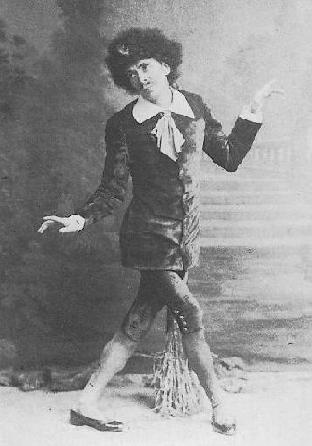 |
| George Grossmith as Reginald Bunthorne (circa 1881) in Patience: a New and Original Aesthetic Opera in Two Acts, by Gilbert and Sullivan, a satire on Oscar Wilde. [9] |
Jazz's more limited relation to homosexuality can be delineated through two
careers. Billy (Dorothy) Lee Tipton, the jazz pianist, performed gender as undetected
drag, but her impeccable improvisations, gift for mimicry, same-sex marriages
and adopted sons may have had more to do with making it in a male-dominated
music and its venues than in a dildo and tuxedo, and serve to show that difference
is in the eye of the beholder (Middlebrook
1998). Billy Strayhorn, composer of one of the most famous titles in the
history of jazz, ‘Take the A Train’, and a good deal else, whom many
people associate with his mentor, Duke Ellington, seems to have willingly accepted
virtual anonymity and the hiding of his abundant talent behind Ellington's benign
and affectionate protection in order to be openly gay (Hajdu
1996: 79–80). Queer lore sees jazz itself (like heavy metal) and its
audience as heterosexual to the core, but John Gill (1995)
explores this half-truth and critiques attitudes towards gay or bisexual jazz
musicians, such as Sun Ra, Cecil Taylor, and Gary Burton, in a manner that has
opened up the topic.
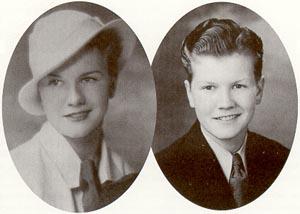 |
| Billy (Dorothy) Lee Tipton (1914–1989) in 1934 as Dorothy and in 1935 as Billy. [10] |
The long tradition of male and female impersonators, who always sang as part
of their act, unlike the lip-synching drag artists of the technological age,
is closely linked with queer presence and representation in popular culture.
The famous openly lesbian male impersonator, Gladys Bentley, who attracted the
rich and famous to her act in Harlem and introduced scat-singing and lewd extemporary
parodies of popular songs as well as explicit lesbian lyrics into her act, represents
a glorious extreme of the inter-war years. At times her strong, fierce voice
ascends into what sounds like a male falsetto, tapping what Emma Calvé called
the ‘fourth voice’ to mark her ‘third sex’. In the USA,
at least, drag and (to a lesser extent) male impersonation carried the stigma
of gender liminality that also marked homosexuality, leading to its being banned
in many places (e.g. Los Angeles) in the repressive 1930s. British drag, on
the other hand, surviving into the television age through such performers as
Benny Hill, indicates the degree to which such acts could help institutionalize
homophobia through ridicule rather than active hate-mongering. Impersonation
and popular music were not outside the force of the closet and the ‘contract’
to which highbrow musicians were obliged to subscribe. Even Julian Eltinge,
perhaps the most celebrated female impersonator of the earlier part of the century
(with a pleasing alto voice), went to great lengths to hide his homosexuality;
indeed, many pop stars have shown extraordinary reluctance to disclose their
sexual orientation (Rodger
1998).
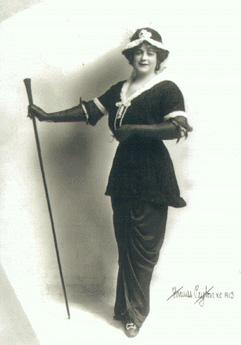 |
| Julian Eltinge (1883–1941) |
On the other hand, Ma Rainey and Bessie Smith could record a number of overtly
lesbian songs in the 1920s, and lesbian and gay performers could become popular
in New York's Prohibition era ‘pansy craze’ (Chauncey
1994). Noël Coward and Cole Porter hardly bothered to hide their interest
in same-sex desire behind sexual innuendo inflected with camp, which functions
in the context of mid-century theatre as a code — to be deciphered by the
homosexual cognoscenti and to go undetected or ignored by others. Later, rock
and roll included homosexuality among its counter-culture effects, through flamboyant
performers like Richard Penniman (‘Little Richard’), and songs like
his 1956 hit, ‘Tutti
Frutti’, or even Elvis Presley's ‘Jailhouse
Rock’ (1957), [11]
with its famous reference to homoerotics behind bars. Later groups such as the
Doors (Jim Morrison singing ‘I'm a
Backdoor Man’ in 1968) [12]
and the Rolling Stones (whose notorious ‘Cocksucker
Blues’ of 1970 Decca refused to release) maintained this tradition.
‘Raga-rock’, almost exclusively associated with George Harrison and
the Beatles, was in fact initiated by the lead singer and principal songwriter
of the Kinks, Ray Davies, with an Indian-influenced song, ‘See
My Friends’ (1965), about his own sexuality; it confirms the often-observed
link between exoticism or Orientalism and Western homosexual culture of all
kinds (Bellman
1998). Further steps led to Lou Reed's ‘Walk
on the Wild Side’ (1972) with its tribute to Andy Warhol's New York
clique, already reflected in the work of the influential group Velvet Underground,
Elton John's ever-popular gay love song, ‘Daniel’
(1972), [13]
to Rod Stewart's ‘The
Killing of Georgie’ (1976), the first top-40 hit unambiguously about
gay people, and to Tom Robinson's celebratory ‘Glad
to be Gay’ (1977). The era also saw a number of independent (even rebellious)
women singers. Janis Joplin, whose major relationships were with women, and
who seemed as unashamed of this as of the rest of her colourful life, possessed
an intensity that might have founded an entire movement, but for her premature
death in 1970. Dusty Springfield, the spirited British soul singer who was a
lesbian icon, survived a career slump in the 1970s and cemented her gay following
by later recording with The Pet Shop Boys.
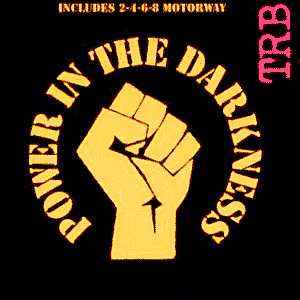 |
| Cover of the Tom Robinson Band (1977–79) début album in 1978, including ‘Glad to Be Gay’. [14] |
In the 1980s the mainstream music industry seemed to respond to the increasing
conservatism of Britain and the USA with further closeting of artists and their
music. David Bowie, for instance, and other glam-rock stars who responded to
the swinging-both-ways 1970s, would no longer advertise their sexual ambivalence
or pretend to be gay, and gay performers in the mainstream were usually guarded
and their songs still coded. A number of British male groups composed largely
or principally of gays — Soft Cell, Frankie Goes to Hollywood, Erasure,
The Pet Shop Boys — maintained a discreet front. Even gender-bending Boy
George and Culture Club kept up evasive talk (such as Boy George's remark about
preferring a nice cup of tea to sex) long after almost anyone had ceased speculating
about them. Morrissey, as we have seen, theorized this evasiveness. Jimmy Somerville
and his group Bronski Beat were a notable exception, performing out songs in
an out manner and hitting the charts at the same time. The openly gay duo Romanovsky
and Phillips became widely known and developed beyond their San Francisco folk
beginnings with their second album, Trouble in Paradise (1986). Surprisingly,
the moody balladeer Johnny Mathis, long an idol for soulful gay youths, came
out in 1982 without much fuss.
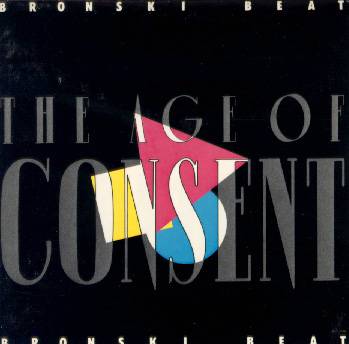 |
| Cover of the Bronski Beat (with Jimmy Somerville) début album in 1984, including the hits ‘Smalltown Boy’, ‘Why’ and ‘It Ain't Necessarily So’. [15] |
V. Music and the AIDS/HIV crisis
The growing
crisis over AIDS and HIV infection (from about 1981 on) which, because it initially
targeted male homosexuals and intravenous drug users in Western societies, received
at first little governmental attention, eventually spurred activism during the
Reagan/Bush-Thatcher years. The artistic communities, which were particularly
hard hit by this pandemic, were further targeted by repressive measures, such
as Republican Party attacks on the National Endowment for the Arts in the USA
and Section 28 of the British Local Government Act (1988), which forbade local
authorities to fund or ‘intentionally promote’ homosexuality and state
schools to teach it as ‘a pretended family relationship’. Signal for
the era, possibly, was the US Supreme Court's majority opinion in the notorious
Bowers v. Hardwick case of 1986 that upheld Georgia's anti-sodomy laws and deemed
‘frivolous’ the claim of a right for consenting adults to engage in
same-sex acts in private (see Sedgwick
1990: 6–7 and 74–82 for a cultural analysis of the case). The
resulting wave of politicization of the arts produced in music a sense of community
manifest in the numerous AIDS benefits and memorials of the late 1980s and early
1990s: for example, the huge Live Aid event at Wembley Stadium and later tribute
to Freddie Mercury, one of the many casualties in popular music; the 1985 hit
(‘That's What Friends Are For’) by Dionne Warwick and Elton John;
concerts among classical music organizations; and a string of commemorative
works. These included John Corigliano's Symphony Number One (1989) and a continuing,
collectively produced AIDS Quilt Songbook (first performed at Alice Tully Hall
in New York in June 1992) that alludes to the great quilt of the NAMES Project
(a collective, international work of art numbering over 43,000 panels, to commemorate
individually those who have died of AIDS). As much a work of protest as commemoration
is Diamanda Galás's three-album project, begun in San Francisco in 1984 with
the title Masque of the Red Death (after Edgar Allen Poe), eventually
becoming the four-movement Plague Mass (as recorded in New York's Cathedral
of St. John the Divine in 1990). Mention should also be made of the songwriter
and AIDS activist Michael Callen, a member of the openly gay a capella group,
the Flirtations, who also issued a solo album in 1988; Holly Johnson of Frankie
Goes to Hollywood and Brian Grillo of Extra Fancy both came out as openly gay
and HIV positive. One of the earliest victims of the disease was German artist
Klaus Nomi (deceased 6 August 1983), celebrated for his bizarre costumes, chameleon-like
voice and unusual musical repertory; switching from earthy cabaret baritone
to sinewy soprano falsetto, and juxtaposing pop songs with operatic arias, he
is celebrated among gay people, especially in Europe, for his haunting soprano
rendition of the ‘Song
of the Cold Genius’ from Purcell's King Arthur.
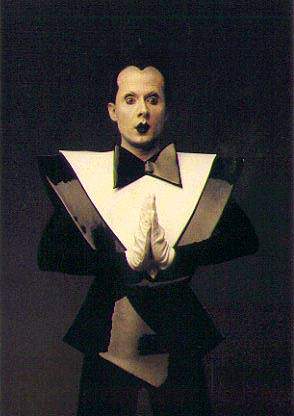 |
| Postcard with Klaus Nomi's image |
A feature of the effect of AIDS and HIV in music was the re-use and reinterpretation of earlier music associated with gay consciousness. Two famous disco hits of the Village People, whose creator, Jacques Morali, died of AIDS in 1991, resurfaced allusively: ‘Go West’ as an AIDS anthem by the Pet Shop Boys, and ‘YMCA’ in a lugubrious ‘classical-music’ version for cello, voice and guitar with clarinet obbligato in the film Longtime Companion (1990). This hilarious arrangement, the opening number in a ‘Living with AIDS’ concert near the end of the film, achieves multiple meanings — mourning the recent dead (as well as the era of sexual freedom and its music) and encouraging survival through gay humour and irony. The first CD of Chrysalis's ‘Red Hot’ series promoting AIDS awareness and benefiting AIDS research and relief consisted of covers of Cole Porter by various artists in a context that gave new and poignant meaning to such songs as ‘I've Got You Under My Skin’: the record not only literally made ‘gay music’ of Porter's songs for the first time but also carried a warning to the listener against letting the music ‘reinforce an overall sense of social abstraction’. Though lesbians and gays devised more radical forms of social protest during the same period (e.g. ACT-UP, Lesbian Avengers, OutRage! and Queer Nation), the adoption by liberal people in general of an issue strongly affecting the queer community marked a distinct change, and support was particularly strong in music and other artistic fields.
This second
wave of political action coincided with changes within musicology and criticism
brought about by the belated impact of poststructural interdisciplinary ways
of thinking. A phenomenon dubbed ‘the new musicology’ began a process
of wresting absolute music from the ideology of universal values, transcendence
and autonomy. It also heralded a more inclusive, as well as more firmly located,
critical practice that refused to leave the category ‘music’ unmarked
in the traditional manner, but embraced all musical phenomena and avoided meaningless
comparisons between different genres and different cultural practices. There
emerged around 1990 a group of lesbian and gay scholars and critics prepared
to work on lesbian and gay topics with a set of procedures derived from feminist
and poststructuralist critiques. Like the lesbian and gay musical organizations
before them, this group also ignored the traditional genre boundaries. The founding
in 1989 of the Gay and Lesbian Study Group (GLSG) of the American Musicological
Society constituted a recognition of this phenomenon.
Among the effects was to throw into
greater relief lesbian and gay composers of the post World War II era. No lesbian
in music before or since Ethel Smyth had been as publicly committed to feminist
activism or as candid about same-sex desire as Pauline Oliveros, who strongly
represented her own lesbian feminism and community in the world of the American
avant-garde from the 1960s onwards. The increasingly celebrated Lou Harrison
had always been assertive of his gay identity. The death of John Cage in 1992
opened the way for long-delayed discussions of his partnership with Merce Cunningham
and the radicalism that stopped short of declaring his sexuality. Important
during the mid-nineties was the self-identifying of eleven gay male composers,
Chester Biscardi, Conrad Cummings, Chris DeBlasio, Robert Helps, William Hibberd,
Lee Hoiby, Jerry Hunt, Robert Maggio, Ned Rorem, David del Tredici and Lou Harrison,
on a CRI recording entitled ‘Gay American Composers’ (1996), followed
a year later by a disc devoted largely to an earlier generation of males —
Barber, Blitzstein, Cage, Copland, Cowell, Harrison, Nikolais, Partch, Thomson,
and Ben Weber — as well as one celebrating lesbian composers of the present
day — Ruth E. Anderson, Eve Beglarian, Madelyn Byrne, Lori Freedman, Jennifer
Higdon, Paula M. Kimper, Marilyn Lerner, Annea Lockwood, Linda Montano, Pauline
Oliveros and Nurit Tilles. These names by no means exhaust possible resources:
the music of Linda Dusman, a lesbian writer as well as composer, might also
be included here as well as that of Laura Karpman, a composer whose work has
been largely in television; among gay male composers, their work featured strongly
by choruses, are Byron Adams, Roger Bourland, David Conte, and Lee Ganon. Several
mainstream recording companies, such as BMG, Teldec and RCA, had already issued
recordings with titles like Out Classics, Sensual Classics and
Classical Erotica, but what these principally illustrated was the increasing
commodification of lesbian or gay desire and its commercial exploitation. Lesbian
musicians and composers, in particular, have a tradition of not only remaining
outside commercial and institutional networks but also of resisting all musical
models, and the work of the composer Sorrel Hays (formerly recorded as pianist
Doris Hays, she is a leading interpreter of Henry Cowell), as well as that of
the performance artist and composer Meredith Monk, strongly maintains that tradition
at a time when lesbian and gay artists were under increasing pressure to join
the mainstream.
The gay presence in music during
the 1990s was enhanced by such works as John Corigliano's Of Rage and Remembrance,
a new version of the third movement of his Symphony Number One incorporating
chorus and soloists, who sing a text by William Hoffman, librettist of The
Ghosts of Versailles, and, in a startling application of chance technique,
the names of personal friends they have lost to AIDS and wish to commemorate.
Harvey Milk, an opera by Stewart Wallace and Michael Korie on the life
and times of the gay activist assassinated in 1978, was not a critical success.
But gay and lesbian opera, as represented, for example, by two successful premieres
of 1998, Matthias Pintscher's Thomas Chatterton (Dresden) and Paula M.
Kimper's Patience and Sarah (New York), became more viable as opera companies
acknowledged the strength of lesbian and gay support.
In popular music, the 1990s also
saw a reversal of the cautious approach of the 1980s and the emergence of openly
lesbian musicians into the mainstream from the alternative space of women's
music. The extraordinary singer-songwriter k. d. lang, who had earlier invaded
the heterosexist field of country music with strongly woman-identified music,
and as a result gained a lesbian following, came out decisively in 1992 (see
Mockus in Brett,
Wood and Thomas eds 1994). So did Melissa Etheridge and Indigo Girls, which
gave lesbians clear representation in popular culture, consolidating, as it
were, the sexually ambiguous representations of Tracy Chapman, Michelle Shocked
and Madonna, as well as the out-lesbian images of Phranc and Two Nice Girls.
The growth in women's punk bands, and the ‘riot grrrl’ phenomenon
of the Pacific Northwest, meant that lesbians could also project a more aggressive
image in music, as in the work of such groups as Tribe 8, Bikini Kill and Team
Dresch (see Coulombe in Barkin
and Hamessley eds 1998).
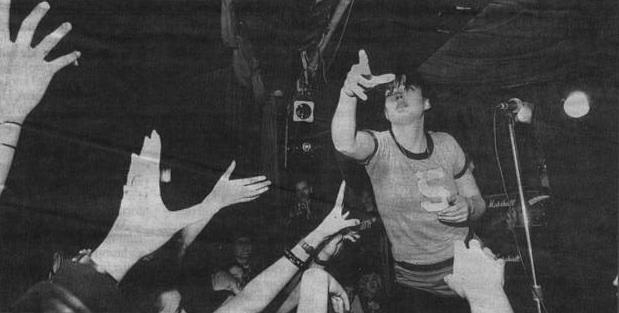 |
| Bikini Kill plays the Bank in 1996, photograph by Dennis Kleiman [16] |
The previously ambivalent Neil Tennant of the Pet Shop Boys came out in 1994,
Michael Stipe of R.E.M. (as bisexual) in 1995, and George Michael in 1998. So
(in The Advocate 12 May 1998) did Rob Halford, famous for three decades
as front man of the heavy metal group Judas Priest. He revealed how simple it
had been to transfer the sometimes scary accoutrements of the gay leather world
on to the metal stage without disturbing the primarily straight male audience.
A knowing gay heavy-metal audience invested in super-masculinity had of course
read/heard homoerotics in place of straight homosocial bonding all along (Walser
1993: 108–36). At the close of the century, numerous lesbian and gay
singers and queercore bands had a crossover popular following, or recorded on
mainstream labels, including Ani diFranco, Echobelly, Janis Ian, Dan Martin
(founder of OutMusic, an organization of lesbian and gay composers and lyricists)
and Michael Biello, Mouth Almighty, Me'Shell NdegéOcello, Pansy Division, Linda
Perry, Placebo, Queer Conscience, Lucy Ray, Skin, Debbie Smith, Suede, Skunk
Anansie, and Sister George. The institution of the Gay/Lesbian American Music
Awards (GLAMA) in 1996 did much to consolidate and encourage an already prolific
field of endeavour.
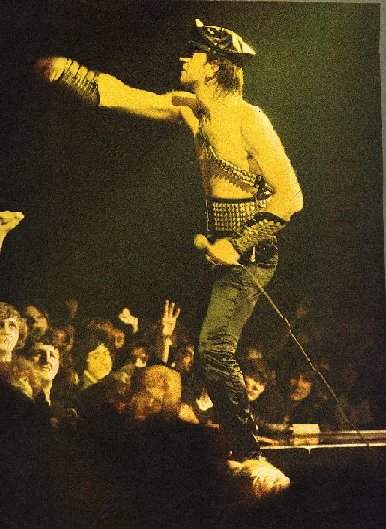 |
| Frontman of Judas Priest for three decades, Rob Halford translated the gay leather scene into straight homosocial bonding. [17] |
By the end of the 1990s, then, an art-form, a scholarly discipline and a journalistic medium that had all set their faces rather sternly against the notion that deviant sexualities had anything to do with them, though the evidence to the contrary lay all around, suddenly found themselves with a modest inundation of ‘queer’ material — to use the term which, once a form of abuse, had been reclaimed around 1990 as an umbrella for the alliance of people of all unorthodox sexualities and those willing to associate with them.
The approach
so far in this discussion has been along the traditional modernist lines of
emphasizing production: the composer and, perhaps less so, the performer. An
arguably better way of defining ‘lesbian and gay music’, and countering
arguments about sexuality and gender's being ‘inaudible in the notes themselves’,
is to invert that model and, invoking the ‘politics and epistemologies
of location, positioning, and situating’ (Haraway
1991: 196), to consider both the audience and particular venues as creating
(if only by contingency and for the moment) a label for the music.
In answer to the question ‘What
is Gay Music?’ posed by Out magazine (November 1996, pp 108–14)
to a number of musicians and people in the music business, Peter Rauhofer said
‘It's all about the diva effect, an attitude that gay people immediately
identify with’. This statement has a certain appeal as a generalization
across 20th century homosexual cultures in the West, including both lesbians
and gay males. Among affluent males the diva effect tends to produce a devotion
to sopranos (Joan Sutherland or Maria Callas, most notably, the latter being
central to Terrence McNally's successful play, The Lisbon Traviata) and
a subject position known as the Opera Queen, widely discussed and theorized
(Bronski
1984, Koestenbaum
1993, Mordden
1984, Morris in Solie
ed. 1993, Robinson
1994). Lesbian devotion may be equally intense, as instanced by the story
of the young woman who committed suicide after being refused admission to Mary
Garden's dressing room (Castle in Blackmer
and Smith eds 1995: 25–26). It differs in attaching itself to dramatic
sopranos, mezzo-sopranos or contraltos, especially if they are suspected of
‘belonging’ (like Garden) or if they cross-dress frequently in such
roles as Orfeo, Octavian or the Poet in Ariadne auf Naxos. The tradition
goes back beyond Garden (George Sand was ‘mad’ about Malibran, and
both she and George Eliot found literary inspiration in the singing of Pauline
Viardot-Garcia) and included among its celebrated divas Olive Fremstad, the
famous butch Wagnerian soprano who is the heroine of Willa Cather's The Song
of the Lark and of Marcia Davenport's Of Lena Geyer (Castle in Blackmer
and Smith eds 1995, Wood in Brett,
Wood and Thomas eds 1994).
The diva effect applies equally in
popular music. If queer culture were religion, then Judy Garland would certainly
be among its chief saints, its heaven ‘Somewhere
over the Rainbow’ (a wish-fulfilling refuge from oppression), The
Wizard of Oz a holy scripture, and ‘Friend of Dorothy’ the mantra
of its votaries. Garland's daughter, Liza Minelli, who starred in Cabaret,
the musical adaptation of Christopher Isherwood's Berlin Stories, almost
established an apostolic succession. Other notable divas might include Marlene
Dietrich, Mae West, Edith Piaf, Zarah Leander (the deep-voiced diva of the German
scene), Bette Midler (who began her career in a New York bathhouse), Barbra
Streisand, and Madonna. Whether these idols experienced same-sex liaisons or
not is beside the point: more crucial are certain characteristics portrayed
in their singing, such as vulnerability (or actual suffering) mixed with defiance,
to which many of their fans relate. The quality of their humour is also an important
ingredient. Several of the women singers already mentioned, notably k. d. lang,
exploit the diva effect, possibly without quite reaching (or wanting) the status
of a Garden, Callas, Ferrier, or Garland.
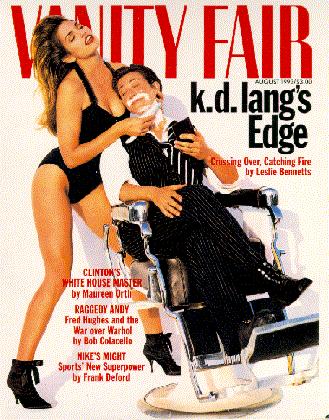 |
| k.d. lang with Cindy Crawford on the cover of Vanity Fair in 1993, changing forever the representation of lesbians in the media. [18] |
The diva effect also has some hold upon exclusively straight audiences; when
it does occur, it is often imbued with camp elements of excess and style associated
with homosexuals. Liberace, for instance, appealed to a broad (but not gay or
lesbian) audience by developing a canny mixture of sentimentalism and transvestism
around his candelabra and piano. His repertory included musical as well as sartorial
camp, for example, his inspired cross-dressing of Cole Porter's ‘Night
and Day’ in the haute couture of Beethoven's ‘Moonlight Sonata’
(for a cultural appraisal see Kopelson
1996:139–85 and Garber
1992). His manipulation of the ‘open secret’ was more extreme
than that of any number of less flamboyant but also closeted gay musicians:
the openly flaunted markings of a hidden identity allowed those who adored him
to use their adoration (and his and their mother-love) to bolster their own
sense of difference and superiority.
Another notable sphere of queer interest
and sponsorship has been the dance floor. Disco is maligned in many quarters,
but dance-club life throughout Europe and the United States was transformed
in the 1970s with the advent of Gloria Gaynor, Patti Labelle, the Pointer Sisters,
Sister Sledge, Donna Summer, Sylvester, The Village People, the Weather Girls
and dozens more, to whose fast-and-heavy beat, colourfully synthesized sounds
and comforting sentiments gay men and sometimes lesbians gyrated and celebrated
‘family’ in safe queer spaces that were close to realizing for the
physicalized and sometimes transcendent moment what opera and The Wizard
of Oz could only begin to suggest. More localized and specialized forms,
such as the even faster and louder House music of the 1980s, and later Acid
and Techno, developed as Disco moved into the straight mainstream. In the 1990s
gay dance music was strongly affected by the artistry of RuPaul, possibly the
recording industry's most successful drag queen. Like rock and roll before them,
Disco and House were heavily derived from black performing styles and sounds,
the African-American diva from Grace Jones to RuPaul being as important here
as in the opera house. They momentarily displaced racial tensions to create
an idealized arena for queer identity to be performed (Currid
1995). Even to consider Disco a category of music is inadequate: it is ‘also
kinds of dancing, club, fashion, film, etc., in a word, a certain sensibility,
manifest in music, clubs, etc., historically and culturally specific, ideologically
and aesthetically determined — and worth thinking about’ (Dyer
1992: 149). This is as close as can be to gay music, one might think, yet
its placing of queer performativity on the platform of black ‘diva-inity’
leads to a complicated play of identification, as Currid (1995)
has shown.
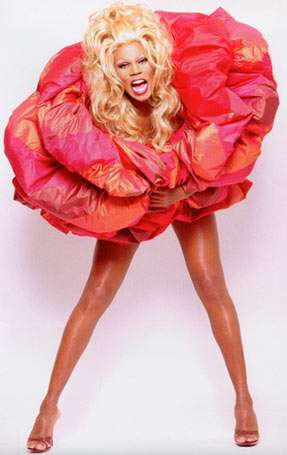 |
| RuPaul, photograph by Albert Sanchez [19] |
Focus on a particular audience and its ‘situated knowledge’ may also
undermine traditional critical arguments seeking to eradicate all identity in
music save nationality. The New York Times review (by Paul Griffiths,
7 July 1998) of Kimper's opera and the CRI recording of the music of lesbian
composers mentioned above, reaches the conclusion ‘that sexual preference,
as well as sex, is inaudible’ and calls that conclusion ‘inevitable’.
The response immediately suggests itself, ‘inaudible to whom’? Modernist
criticism, anxious to check the proliferation of meaning and keep forms of authority
and canons of taste in place, puts the onus of proof on ‘the music itself’.
But the notes cannot so easily be separated from their context (of performance,
venue, genre and audience, as well as musical allusion): if stripped of all
associations — an impossibility — they can yield no meaning.
In some few cases, such as the bizarre
juxtapositions in Poulenc's instrumental music, a homosexual sensibility is
clearly audible, but then only to someone who has some grasp of the aesthetics
of that much-discussed but uneasily defined phenomenon known as ‘camp’.
Further, the orientalism or exoticism of a great range of 19th and 20th century
music can be heard not simply as decorative acculturation but as an audible
manifestation of some dissatisfaction with prevailing Western mores.
More complicated musical strategies, such as the set of motivic and tonal interactions
that signal the tragedy of internalized oppression in Peter Grimes, may
be revealed as criticism involves itself more deeply and widely with such questions.
Such markers, however, are possibly more prevalent in (closeted) homosexual
culture in which classical music is so heavily implicated than in openly lesbian
or gay music, such as Disco or the kinds of alternative women's music mentioned
above. Here, context exerts so powerful an influence as to overthrow conventional
associations: even the opening of Beethoven's Fifth Symphony, that quintessential
model of heroic masculinity, met its gay destiny when, tricked out with a heavy
beat and other accoutrements, it hit the Disco scene in the 1970s as ‘A
Fifth of Beethoven’.
‘The identity of music is the sacred issue’, Philip Bohlman explains (referring to McClary 1991): ‘That women, working-class labourers, gays and lesbians, blacks, religious or ethnic communities, or anyone else should identify music in some other way or imagine music to embody completely different and differentiated cultural spaces, that becomes blasphemy against “what MUSIC is”. Imagined in this way it may not be MUSIC anymore’ (Bohlman 1993: 417).Accordingly, an important strategy among lesbian and gay critics is to insist on the possibility and the importance of different receptions of all kinds of music, an insistence which can undermine any authority or objectivity criticism might claim for itself, and of destroying the essentializing or minoritizing drive to confine lesbian and gay music criticism to style analysis. Suzanne Cusick, in an extremely radical statement quite early in the movement's history (delivered at the first Feminist Theory and Music conference, 1991), insisted on, and explored, a special lesbian relationship to music itself (Brett, Wood and Thomas eds 1994). This gesture, going (in the gentlest manner) all the way, so to speak, prepared the ground for a good deal of critical work since (not all of it written by self-identifying lesbian, gay or bisexual critics, to complicate the picture even further) that refuses previous protocols in an effort to reach imaginative and varied views as to what kinds of phenomena might coexist as ‘lesbian and gay — or queer — music’ and how these might relate to whole sets of other positions, even the hegemonic one.
VIII. Anthropology and History
The discussion
so far has pertained to the 20th century, to Europe, North America and their
outposts, and has largely been confined to recent musical phenomena. ‘Lesbian
and Gay Music’ is arguably confined to these specific times and places
and even then needs greater inflection to describe exactly what was going on
in those West German clubs, or to note that the Front d'Alliberament Gai de
Catalunya (FAGC), founded in 1977, was more bound up with Catalonian independence
and soulful Catalonian song than with American disco. Beyond the ‘West’
the dilemma becomes even more apparent. In non-Western musics, gender and sexual
ambiguities and inversions, not to mention same-sex sexual practices, found
in many cultures with different musics and different sexualities, have drawn
the imagination of the West, with its attraction to and cultural fantasies about
them. The symbolic inversions around the cross-dressed male ‘talèdhèk’
in Balinese song and dance; transsexual performance by spirit-guides or ‘halaa’
among Temiar people; the Hawai'in ‘mahu’ of indeterminate gender;
or the Mapuche of the southern Andes: all these bear witness to the warning
that ‘gay, lesbian, bisexual, homosexual, heterosexual [...] conjure but
a limited glimpse of the variations on gender that are beginning to emerge from
cross-cultural research’ and ‘reduce the complexity of personhood
to a handful of oppositions contrived by an ethnocentric discourse’ (Robertson
1992).
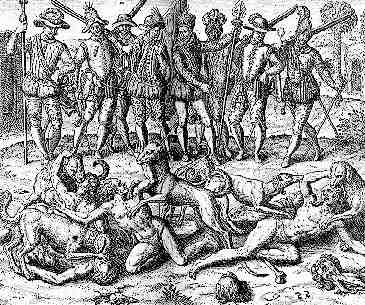 |
| The violence of a European encounter with the ‘New World’ in a 16th century illustration: in 1513 Balboa fed to his dogs forty Panamanian Indians accused of sodomy, a common charge against native peoples. [20] |
Some of the musics of non-Western cultures became source material for homosexual
Western composers cruising off-limits, but cannot be amalgamated with or subsumed
under a Western category. Homosexual or pederastic composers from Saint-Saëns
onwards were at one time particularly susceptible to the attractions of Orientalism,
perhaps because of the projection of illicit sex discerned by Said's critique
(1978),
perhaps, as Lou Harrison has suggested, because of an identification with the
Other, or even (as in the case of Cage) because of dissatisfaction with available
resources: this topic remains problematic and interesting in relation to lesbian
and gay music. But since orientalism in music at the turn of the present century
is represented most strongly by non-gay minimalism, no essentialist link ought
to be imagined. Interestingly, Ethnomusicology has been even more nervous of
categories of sexual behaviour manifest in music than has historical musicology.
Given that sexuality itself is a
modern invention, a long history of homosexuality in music is an impossibility.
There is room, however, to explore how same-sex sexual or erotic relations are
regarded in different times and places and how the social experience of being
involved in them might affect musical utterance: ‘it will be history written
from the perspective of contemporary gay interests’ (Halperin
1990: 29) asking questions never posed during musicology's long love-affair
with straight fact. An example might be the placing of Hildegard of Bingen's
lyrical effusions in a context of the medieval eroticization of the body focussed
(in her case) on same-sex desire. Pointing out ‘how insistently “queer”
medieval Christianity can be’, Holsinger (1993:
120) suggests that ‘rather than looking for “actual” lesbians
and gay men in the Middle Ages, why not try outing medieval devotion itself?’
Turning to organum, he explores the writings that constantly represent polyphonic
practice in corporeal terms as ‘coupling’ (copula), and in
relational terms as the product of their male singers. Such rhetoric, he suggests,
not only explains the constant link between sodomy and polyphony in the puritan
tradition, but uncovers a queerness at the very heart of organum that is also
represented in some homoerotic verses of its leading composer, Leoninus (Holsinger
2001, chapter 4). Ironically, then, the polyphony and harmony that differentiate
Western music most notably from that of other cultures was from the start connected
to same-sex desire, and ‘art music’ originally fell into disrepute
through roughly the same association that it has been trying so hard to avoid
in the 20th century.
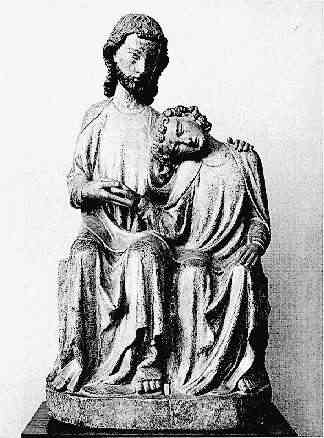 |
| This 14th century sculpture of an older Christ with the youthful Saint John illustrates what Boswell calls ‘the tradition of passionate friendship common among the monastic clergy of the Middle Ages’. [21] |
There seem few enough clues at present about how the frequent accusation of
sodomy against musicians of the late medieval and early modern periods should
play into a notion of the music they produced. It is not known whether composers
like Nicolas Gombert, Dominique Phinot, Tiburzio Massaino, Johann Rosenmüller
and Jean-Baptiste Lully shared anything but shame for their sexual desires,
and whether even that affected their composition. The first four undoubtedly
suffered, Gombert serving a three-year stint in the galleys, Phinot being executed
(his body was burnt), Massaino going into exile, and Rosenmüller being imprisoned
together with the schoolboys involved. A canon at Loreto, Luigi Fontino, was
beheaded in 1570 for sodomy with a choirboy (Sherr
1991); and it has been suggested that Gombert's first book of motets (1539)
may have been assembled as an apologia with a view to gaining him a pardon (Lewis
1994: 333–67). Lully, on the other hand, made a fortune and founded
an operatic tradition, apparently undamaged by attacks on ‘les sodomites’
at court, that culminated for him in the removal from his house of the page,
Brunet, whom he was suspected of sodomizing. Moreover, since the librettist
Campistron was a member of the sodomitical court circle, Lully's last two stage
works, Acis et Galatée (1686) and Achille et Polyxène (1687),
may represent the earliest known ‘gay collaboration’.
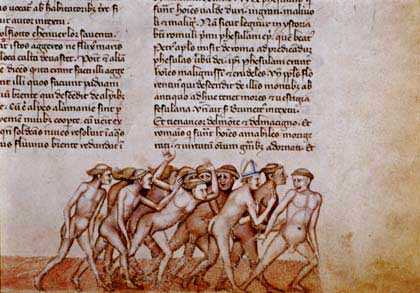 |
| Illumination by a Tuscan artist representing sodomites in a manuscript of Dante's ‘Hell’ with commentary written by the Carmelite friar Guido de Pisa around 1327–28, Condé Museum, Chantilly. [22] |
If Lully's case is well documented, particularly in ribald contemporary comments,
recent speculation about Zelenka — ‘a mad, gloomy homosexual whose
music is also mostly mad and gloomy’ (R. Morrison, The Times, 17
June 1998) — appears to derive solely from a structural and semantic analysis
of the Czech composer's trio sonatas (Reich
1987). No evidence concerning Zelenka's sexuality or sexual practices survives;
he remained unmarried and was a solitary and unassuming figure, seen by some
contemporaries as a reserved, even bigoted, Catholic. It is one thing to infer
a musician's participation in same-sex culture and to examine ideological traces
of homophobia in the scholarly and critical literature that result from the
musician's status as a ‘suspect’ (as with Thomas's essay on Handel
in Brett,
Wood and Thomas eds 1994), but quite another for same-sex desire to be discerned
internally and then used to make a lesser-known composer of the period appear
deviant and exciting and his music therefore more marketable. The heady mixture
of Catholicism and homoeroticism on which this new Zelenka image trades belongs
rather to the late 19th century, as exemplified in the decadent movement and
such key figures as J.-K. Huysmans, Walter Pater, and Oscar Wilde (see Hanson
1997), than to the early 18th century.
Very different from this case is
the increasing number of examinations of works for cultural traces that are
writ large in the surrounding societal context, or identity-based critical interpretations
enriched with a sense of the history of culture. Work on communities of nuns
and on the many women composers of Italy, for instance, has prompted questions
about how early modern religious eroticism might reflect an erotics of these
suppressed voices, and has invited lesbian interpretations of the work of the
many religious women who exhibit extravagant devotion to the Virgin Mary. Recent
work (by Cusick) on Francesca Caccini also shows how a feminist and specifically
lesbian approach can enliven and illumine the discussion of historical issues
around music and the patriarchy. In view of the various inflections of the Orpheus
legend, too, significance has been read into the fact that in the Monteverdi-Striggio
Orfeo the male singer loses his female lover only to ascend to heaven
in the arms of another man. Whether or not Handel slept with other men, the
revelations about the circles in which he moved — and exactly how his modern
biographers articulate their anxiety about the possibility he might have done
so — makes Thomas's essay a salutary contribution to Handel scholarship.
The castrated male who is the central figure of every opera seria in Handel's
time not only complicated questions of gender and sexuality but also embodied
the threat represented by the music itself: these ‘Italian Syrens’
are compared by the anonymous author of Satan's Harvest Home (1749) to
the ‘Chromatic Musick’ of ancient Greece and the ‘Women Singers
and Eunuchs from Asia’ by whose agency, apparently, the ancient Romans
‘quite lost the Spirit of Manhood, and with it their Empire’. Italy
was ‘the Mother and Nurse of Sodomy’ where ‘not a Cardinal or
Churchman of Note but has his Ganymede’ (pp 51 and 56). In North Germany
an Italian castrato was not needed to sound the anti-effeminate alarm: mere
minuets in symphonies seemed to J. A. Hiller ‘like beauty spots on the
face of a man: they give the music a foppish appearance, and weaken the manly
impression made by the [...] serious movements’ (Head
1995).
A lesbian and gay discourse about
music will undoubtedly wish to do even more in the way of exhuming those musicians
identified with same-sex desire. But there are equally important issues to be
addressed. Attention has been drawn to the homophobia in traditional musical
scholarship. Whether it be the horror of the prospect of a deviant Handel or
Schubert, the assumption that their sexuality makes Ravel, say, or Britten,
the victims of ‘that fatally aimless cleverness which is a symptom of decadence’
(Grove, 6th ed., v 15, p 617), the invention of an ‘artistic persona’
(following literary New Criticism) to evacuate the connection between the life
of a lesbian or gay artist and her/his work of all meaning, or the recent movement
to import from literary criticism Harold Bloom's theory of the ‘anxiety
of influence’ with its assumption that male relations are always fraught
with contention rather than love (Whitesell
1994–95), an opposing or context-providing protest has to be registered,
often over and over again. Alternative procedures need to be followed that do
not leave homosexuality lying unregistered in the clothes of the open secret
as mere decadence or a taste for elaboration. Inevitably part of the focus will
be questions of artistic collaboration (such as that between Virgil Thomson
and Gertrude Stein, Britten and Pears), sponsorship (by the Paris salon and
circle of the Princesse de Polignac, for example, including the legendary Nadia
Boulanger, and in American music around Bernstein, Copland, Menotti and Barber),
and even the effect on heterosexually-identified composers of being liberated
by a circle consisting largely of homosexuals and their culture, as was Stravinsky
by the Mir iskusstva (‘World of Art’) group around Diaghilev,
or of their music becoming the centre of a homosexual cult, as Wagner's appears
to have become in Germany.
The greater challenge for a
lesbian and gay approach is undoubtedly the German canon in art music and its
satellites. Composers like Handel and Schubert, even the effeminized Chopin,
are still assumed to be stable entities, and scholarship about them continues
to assume the default position of sexual orientation until such time as documentation
is discovered that equals Casanova's bursting in on Winckelmann while the distinguished
classical scholar was putting Greek Love to the practical test in his Rome apartment.
The literature about these bachelor composers reveals, however, a constant embarrassment
or evasion that supports the point about an ingrained homophobia in music scholarship.
Furthermore, since sexual orthodoxy can never be assumed, especially among musicians,
the constant parade of heroism and masculinity in the repertory from Beethoven
to Strauss, and its representation in criticism and scholarship, begins to look
more and more like a ruse to divert attention from an endemic queerness so firmly
repressed that even to suggest it is an unpardonable error of taste and judgment
(as in the cases of Beethoven, Schumann, and Brahms).
More nuanced studies of the circumstances
of all these composers may link them to patterns of same-sex love or desire
that have been discerned among the literary figures of the age of sensibility
and of Romanticism. That these patterns did not always or inevitably include
sexual acts in no way lessens their intensity or importance. Reception of their
music from a lesbian or gay standpoint (e.g. Cusick
1994b, Brett
1994, Wood
2000) should broaden the range of criticism across the entire historical
spectrum, throw new light on the meanings people attach to the music they identify
with, and help to open the way toward new conversations about the power of music
of various kinds in peoples' lives.
Finally, arriving full circle at
the sexological discourse with which the article opened, we encounter the figure
of Pyotr Ill'yich Tchaikovsky (1840–93), Western music's first and still
most celebrated ‘homosexual’. As early as 1908 he was called the one
‘thorough-going Uranian’ to attain ‘to the highest eminence in
the art’ (Carpenter
1908: 111). Other candidates might have been found: his fellow countryman,
Modest Musorgsky (1839–81), for instance, or his friend Camille Saint-Saëns
(1835–1921); but the one was a symbol of nationalism (and therefore difference)
and the other not a tremendous threat to German hegemony (besides, he firmly
resisted the new-fangled homosexuel in favour of the traditional label
pédéraste). Tchaikovsky was without peer in reaching a German level of
technique and formal command, even exceeding the celebrated German composers
in popularity with concert audiences. His manifest deviance enabled critics
so minded to keep the German symphonists themselves untainted and spotless.
It is worth noting, in the light of some of the criticism that has linked Tchaikovsky's
supposed sentimentality, morbidity and lack of formal values with his sexuality,
that his concert music was initially heard as ‘free from the frightful
effeminacy of most modern works’ (Bernard Shaw) and as ‘impersonal’
and containing ‘glimpses of the strong man's hand’ (Ernest Newman,
see Brown
1999). Once the penny dropped about the composer's failed marriage and other
obvious pointers to his condition given by his brother Modest in a monumental
biography made available by Newmarch's condensed translation of 1905, the critical
abuse, stemming from a direct connection of the works to the life uncharacteristic
of high modernist dogma, constitutes a clear case of institutionalized bigotry;
it ran from ‘quite like a schoolgirl’ and ‘truly pathological’
to ‘must we be shown all his sores?’, and the perpetrators were not
obscure but critics like Gerald Abraham, Martin Cooper, James Huneker and Edward
Lockspeiser (Brown, ibid.).
At the end of the century, Tchaikovsky
remained the bellwether of attitudes to homosexuality in music. In novels, plays,
films and other representations in dominant culture, the homosexual always dies,
and it is significant that a fierce controversy has developed around the death
of Tchaikovsky. An entire scholarly monograph has been devoted to the topic
(Poznansky
1996). The rumour and gossip upon which homosexuals have had to depend to
construct our history are everywhere apparent in this saga, which includes suicide
at the direction of Tsar Alexander III, suicide on his own volition to avoid
a homosexual scandal, suicide at the suggestion of his gay brother Modest and,
most recently, suicide at the direction of some former classmates worried to
death about the honour of the old school. Nor is it clear which version, the
‘official’ account of typhoid in the biography of Modest or one of
the rumours, is the more homophobic. The myth of the tortured, morbid homosexual
taking his own shameful life is one kind of essentialist stereotype, but the
‘gay-positive’ image of a homosexual composer of this period experiencing
no tensions about his sexuality is equally essentialist and unrealistic. Still,
the very idea of a successful, wealthy, world-honoured composer at the height
of his powers and productivity committing suicide at the direction of some lawyer
bullies he knew from his schooldays makes little sense, not even as sado-masochistic
pornographic fiction. Yet the myths and projections are so abundant that the
truth is unlikely to be revealed, even to a biographer of the British Royal
Family, one of the more recent to tackle the topic (Holden
1995).
A lesbian or gay approach to Tchaikovsky's
life would most likely focus on his lively aspects, and the difference he made
to the fields of concert music, opera and ballet. For instance, Matthew Bourne's
remarkable reinterpretation of Swan Lake (1995), in which a tightly feathered
male corps replaced the swans in tutus and the love music became the occasion
for breathtakingly homoerotic spectacle, attained for some an authenticity beyond
anything imagined by historically informed performing practice. It would also
consider evidence for the complicated layering of transgression and compliance
that resulted from the construction of homosexuality as a role or identity,
as well as for points of resistance, such as the entire ballet Tchaikovsky and
Saint-Saëns danced for each other during the latter's visit to Moscow for a
concert in December 1875.
As young men, both had not only been very attracted to the ballet, but had also some natural skill for that sort of dancing. And so once, wishing to show off their art to each other, they performed on the stage of the Conservatoire's hall an entire little ballet, Galatea and Pygmalion. The 40-year-old Saint-Saëns was Galatea, and performed the rôle of the statue with remarkable assiduity, and the 35-year-old Tchaikovsky took upon himself the part of Pygmalion. Nikolay Rubinstein [the pianist who had played the French composer's two-piano Variations with him in the Moscow concert] provided the orchestra (M. Tchaikovsky, translation in Brown 1982).A couple of middle-aged queens, one in drag, camping it up on the main stage of the Moscow Conservatory? Not simply that, because, according to Modest, they were showing off their art to each other (those pliés, those jétés!). And there were no witnesses other than the hapless pianist. Their performance epitomizes the social predicament of homosexual musicians throughout the ensuing century: two composers, celebrated throughout Europe, occupying a central site, the stage of the Moscow Conservatory, to enact a closet drama; private delight cannot have been unmixed on that occasion, as on so many others in so many other lives, with the apprehension of disclosure.
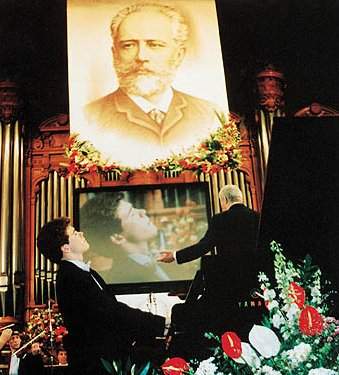 |
| The Cavaillé-Coll organ in the Great Hall of the Moscow Conservatory sorrounded by flower arrangements and crowned with effigy of Tchaikovsky in a pianistic final: a classic of camp. [23] |
Such tensions of the human spirit brought about by the forces of oppression and the counterforces it also generates are much in need of deciphering in order to make greater sense of social and musical experience, both then and now. By focussing on such matters, a gay and lesbian perspective has the means to expand the entire critical and historical enterprise.
We wish to thank many people for their help, in particular Byron Adams, John Beynon, Malcolm Hamrick Brown, Susan Leigh Foster, Bruce Holsinger, George Haggerty, Nadine Hubbs, Patrick Macey, Martha Mockus, Davitt Moroney, Mitchell Morris, Gillian Rodger, Carole-Anne Tyler, Carroll Smith-Rosenberg, Lloyd Whitesell and Daniel J. Wolf.
[*] The editor is indebted to Pedro Durães for help with editing of audio files and to Luiz Otávio Fernandino Tinoco for help with editing of image files and fomatting of the HTML document.
[1] See the article ‘How Music Got its Grove Back’, in the Independent, 30 December 2000:
The big threat now, of course, is from the PC thought-police. One of Sadie's innovations is a series of articles on attitudes and ideologies: no problem with Nazism or Marxism, or with nationalism — on which the formidable Richard Taruskin pontificates — but the discussion of homosexuality gave a lot of problems. Sadie has an article on gay and lesbian music, whose authors — a male Brit and an Australian female — initially wanted it billed as ‘lesbian and gay music’.The full article is available online at <http://www.independent.co.uk/story.jsp?story=48198>.
‘I said no to that, and I also suggested that “gay” covered both sexes, but they said no to that. In fact, I said no to quite a lot of things. They wanted to list gay and lesbian composers, and I said you can't do that without specific permission if they're alive, and I didn't like it being done if they were dead.’ He pours scorn on the sexual fellow-travellers who now claim Schubert as gay. ‘The evidence is non-existent, but you can't say that in America without being branded a homophobe.’ (Op. cit.)
[2] For additional information on these authors, see <http://www.gayhistory.com/> and the website of the Magnus Hirschfeld Archive for Sexology in the Humboldt University of Berlin, <http://www2.hu-berlin.de/sexology/>, from where these images were taken.
[3] Image taken from the unofficial website <http://www.petshopboys-online.com/>.
[4] Image taken from the Millenium Muster website, <http://ronpearse.members.beeb.net/rightframe.htm>; see <http://ronpearse.members.beeb.net/people/smyth.htm>.
[5] Used on the jacket cover of Martin Duberman's Stonewall (New York: Penguin, 1993); image taken from Stonewall and Beyond: Lesbian and Gay Culture, the online edition of a Columbia University Libraries exhibition held from 25 May to 17 September 1994 in conjunction with the international celebration of the twenty-fifth anniversary of the Stonewall Riots, <http://www.columbia.edu/cu/lweb/eresources/exhibitions/sw25/index.html>.
[6] Image taken from Madonna Zone, <http://www.madonna.cz/>.
[7] Excerpt taken from the 1956 film with Shirley Jones.
[8] Excerpt taken from Tom Robinson's humorous version.
[9] Used in Robin Wilson e Frederic Lloyd's Gilbert & Sullivan: The Official D'Oyly Carte Picture History (New York: Knopf, 1984); image taken from Stonewall and Beyond: Lesbian and Gay Culture, the online edition of a Columbia University Libraries exhibition held from 25 May to 17 September 1994 in conjunction with the international celebration of the twenty-fifth anniversary of the Stonewall Riots, <http://www.columbia.edu/cu/lweb/eresources/exhibitions/sw25/index.html>.
[10] Image taken from Diane Middlebrook's website, <http://www.dianemiddlebrook.com/>, where it appears by courtesy of W. T. Tipton.
[11] Excerpt taken from a 1958 live recording with Cliff Richard.
[12] Excerpt taken from a 2 May 1970 Pittsburgh show.
[13] Excerpt taken from an acoustic live performance.
[14] Image taken from Tom Robinson's official website, <http://www.tomrobinson.com/>.
[15] Image taken from Jimmy Somerville's official website, <http://www.jimmysomerville.co.uk/>.
[16] Image taken from <http://www.columbia.edu/~rli3/music_html/bikini_kill/picture.html>.
[17] Image taken from the Spanish website <http://galeon.hispavista.com/hellbentforjudas/familia12334.html>.
[18] Cover of Vanity Fair, August 1993 (New York: Conde Nast Publications); image taken from Stonewall and Beyond: Lesbian and Gay Culture, the online edition of a Columbia University Libraries exhibition held from 25 May to 17 September 1994 in conjunction with the international celebration of the twenty-fifth anniversary of the Stonewall Riots, <http://www.columbia.edu/cu/lweb/eresources/exhibitions/sw25/index.html>.
[19] Image taken from the official website, <http://www.rupaul.com/>.
[20] Used in Jonathan Goldberg's Sodometries: Renaissance Texts, Modern Sexualities (Stanford: Stanford University Press, 1992); image taken from Stonewall and Beyond: Lesbian and Gay Culture, the online edition of a Columbia University Libraries exhibition held from 25 May to 17 September 1994 in conjunction with the international celebration of the twenty-fifth anniversary of the Stonewall Riots, <http://www.columbia.edu/cu/lweb/eresources/exhibitions/sw25/index.html>.
[21] Used in John Boswell's Christianity, Social Tolerance, and Homosexuality: Gay People in Western Europe from the Beginning of the Christian Era to the Fourteenth Century (Chicago: University of Chicago Press, 1980); image taken from Stonewall and Beyond: Lesbian and Gay Culture, the online edition of a Columbia University Libraries exhibition held from 25 May to 17 September 1994 in conjunction with the international celebration of the twenty-fifth anniversary of the Stonewall Riots, <http://www.columbia.edu/cu/lweb/eresources/exhibitions/sw25/index.html>.
[22] Manuscript presented in the exhibition Italian Illuminations: Masterpieces of the Condé Museum in Chantilly (14th to 16th centuries) from 27 September 2000 to 27 January 2001; image taken from the Institut de France website, <http://www.institut-de-france.fr/>; see <http://www.institut-de-france.fr/patrimoine/chantilly/expo2.htm>.
[23] Photograph published in Accent Online 32 (Yamaha Corporation of America, 1999), <http://www.yamaha.com/musiced/accent/Accent199/toc.html>.
Lesbian Concentrate: A Lesbianthology of Songs and Poems. Olivia Records (Los Angeles, 1977).
Red Hot + Blue: A Tribute to Cole Porter to Benefit AIDS Research and Relief. Chrysalis F2 21799 (New York, 1990). Videorecording also available. Score arr. R. Day (Secaucus, N.J: Warner Chappell Music, 1991).
The AIDS Quilt Songbook. Harmonia Mundi USA, HMU 907602 (Los Angeles, 1994).
John Greyson and Glenn Schellenberg. Zero Patience: A Music about AIDS. Milan Entertainment 731383–35675–2 ([New York?], 1994).
Gay American Composers. CRI, CD 721 (New York, 1996).
And Trouble Came: Musical Responses to AIDS. CRI, CD 729 (New York, 1996).
Gay American Composers. Volume 2. CRI, CD 750 (New York, 1997).
Club Verboten. DCC Compact Classics DZS (4)–135 (Chatsworth, CA, 1997). Notes by R. Oliver.
Lesbian American Composers. CRI, CD 780 (New York, 1998).
Composer studies, except those quoted in the text, have been omitted. Further resources are music entries in the Encyclopedia of Lesbian and Gay Histories and Cultures, ed. Bonnie Zimmerman and George E. Haggerty (New York: Garland, 2000), The St. James Press Gay and Lesbian Almanac, ed. Neil Schlager (Detroit: St. James Press, 1998) and the “Current Bibliography” of the GLSG Newsletter (1990–), which indexes American lesbian, gay and other magazines, such as The Advocate, Curve, Lavender Lifestyles, Out, Rolling Stone, and Village Voice.
E. CARPENTER. The Intermediate Sex (London, 1908).
H. ELLIS. Sexual Inversion, Studies in the Psychology of Sex (Philadelphia, 3/1915).
D. ALTMAN. Homosexual: Oppression and Liberation (New York, 1971, 2/1993).
E. H. IBARS. Gay Rock (Madrid, 1975).
P. BRETT. ‘Britten and Grimes’. Musical Times 117 (1977): 995–1000.
M. FOUCAULT. The History of Sexuality: Introduction. Tr. R. Hurley (New York, 1978).
E. SAID. Orientalism (New York, 1978).
T. AVICOLLI. ‘Images of Gays in Rock Music’. Lavender Culture. Ed. K. Jay and A. Young (New York, 1979), pp 182–94.
G. WEEKS. Sex, Politics and Society: The Regulation of Sexuality since 1800 (London, 1981).
D. BROWN. Tchaikovsky 2. (London, 1982).
J. D'EMILIO. Sexual Politics, Sexual Communities: The Making of a Homosexual Minority in the United States, 1940–1970 (Chicago, 1983).
P. BRETT, Ed. Benjamin Britten: Peter Grimes (Cambridge, 1983).
M. BRONSKI. Culture Clash: The Making of Gay Sensibility (Boston, 1984).
E. MORDDEN. Demented: The World of the Opera Diva (New York, 1984).
D. RIMMER. Like Punk Never Happened: Culture Club and the New Pop (London, 1985).
S. SIMELS. Gender Chameleons: Androgyny in Rock and Roll (New York, 1985).
H. BERNSTEIN and W. SEVERSON, Eds. Catalogue of Musical Works by SGLC Members (San Francisco, 1986).
W. REICH. ‘Die Triosonaten von Jan Dismas Zelenka. Untersuchungen zu ihrer Struktur und Semantic’ (Chapter 2). Zwei Zelenka-Studien 7 (Dresden, 1987).
M. SOLOMON. ‘Charles Ives: Some Questions of Veracity’. Journal of the American Musicological Society 40 (1987): 443–70.
H. KINGSBURY. Music, Talent, and Performance: A Conservatory Cultural System (Philadelphia, 1988).
D. A. MILLER. The Novel and the Police (Berkeley, 1988).
H. CHRISTOPHERSON and J. MCLAREN. The Encyclopedia of Gay and Lesbian Recordings (Amsterdam, 1989).
E. GARBER. ‘A Spectacle in Color: The Lesbian and Gay Subculture of Jazz Age Harlem’. Hidden from History: Reclaiming the Gay and Lesbian Past. Ed. M. Duberman, M. Vicinus and G. Chauncey (New York, 1989).
E. A. GORDON. Mark the Music: The Life and Work of Marc Blitzstein (New York, 1989).
C. HINDLEY. ‘Love and Salvation in Britten's “Billy Budd”’. Music and Letters 70 (1989): 363–81 (for further items see ‘Britten, Benjamin’).
M. SOLOMON. ‘Franz Schubert and the Peacocks of Benvenuto Cellini’. Nineteenth Century Music 12 (1989–90): 193–206.
J. BUTLER. Gender Trouble: Feminism and the Subversion of Identity (New York, 1990).
E. A. GORDON. ‘GALA: The Lesbian and Gay Community of Song’. Choral Journal 30/9 (1990): 25–32.
D. HALPERIN. One Hundred Years of Homosexuality and other Essays on Greek Love (New York, 1990).
L. D. MASS. Homosexuality as Behavior and Identity: Dialogues of the Sexual Revolution. 2 vols. (New York, 1990).
T. MCNALLY. ‘The Lisbon Traviata’. Three Plays by Terrence McNally (New York, 1990), pp 1–88.
E. K. SEDGWICK. Epistemology of the Closet (Berkeley, 1990).
W. BREAUN. ‘Urteile über Johann Rosenmüller’. Von Isaac bis Bach: Festschrift Martin Just. Eds F. Heidlberger, W. Osthoff and R. Wisend (Kassel, 1991), pp 189–97.
D. HARAWAY. Simians, Cyborgs, and Women: The Reinvention of Nature (New York, 1991).
M. HICKS. ‘The Imprisonment of Henry Cowell’. Journal of the American Musicological Society 44 (1991): 92–119.
S. MCCLARY. Feminine Endings: Music, Gender, and Sexuality (Minneapolis, 1991).
M. N. SMITH. ‘Sexual Mobilities in Bruce Springsteen: Performance as Commentary’. South Atlantic Quarterly 90 (1991): 833–54.
R. SHERR. ‘A Canon, a Choirboy, and Homosexuality in Late Sixteenth-Century Italy: A Case Study’. Journal of Homosexuality 21 (1991): 1–22.
M. TIPPETT. Those Twentieth-Century Blues: An Autobiography (London, 1991).
R. DYER. Only Entertainment (London, 1992).
M. GARBER. Vested Interests: Cross Dressing and Cultural Anxiety (New York, 1992).
L. MASS. ‘Musical Quilts’. GLSG Newsletter 2, n 2 (1992): 11–13.
F. MAUS. ‘Hanslick's Animism’. Journal of Musicology 10 (1992): 273–92.
M. MORRIS. ‘On Gaily Reading Music’. repercussions 1, n 1 (1992): 48–64.
J. PERAINO. ‘“Rip Her to Shreds”: Women's Music According to a Butch-Femme Aesthetic’. repercussions 1, n 1 (1992): 19–47.
C. ROBERTSON. ‘What's In a Name’. GLSG Newsletter 2, n 1 (1992): 21.
D. C. STANTON. ‘Introduction: The Subject of Sexuality’. Discourses of Sexuality from Aristotle to AIDS. Ed. D. C. Stanton (Ann Arbor, 1992).
H. ABELOVE, M. A. BARALE and D. M. HALPERIN, Eds. The Lesbian and Gay Studies Reader (New York, 1993).
P. BOHLMAN. ‘Musicology as a Political Act’. Journal of Musicology 11 (1993): 411–36.
J. BUTLER. Bodies That Matter: On the Discursive Limits of ‘Sex’ (New York, 1993).
S. CITRON. Nöel and Cole: The Sophisticates (Oxford, 1993).
D. CLARKE. ‘Tippett In and Out of “Those Twentieth-Century Blues”: The Context and Significance of Autobiography’. Music and Letters 74 (1993), 399–411.
M. DUBERMAN. Stonewall (New York, 1993).
L. GARBER. Lesbian Sources: A Bibliography of Periodical Articles, 1970–1990 (New York, 1993).
B. W. HOLSINGER. ‘The Flesh of the Voice: Embodiment and the Homoerotics of Devotion in the Music of Hildegard of Bingen (1098–1179)’. Signs 19 (1993): 92–125.
W. KOESTENBAUM. The Queen's Throat: Opera, Homosexuality, and the Mystery of Desire (New York, 1993).
A. LAKI. ‘The Politics of Dancing: Gay Disco Music and Postmodernism’. The Last Post: Music after Modernism. Ed. S. Miller (Manchester, 1993), pp 110–31.
D. SCOTT. ‘Sexuality and Musical Style from Monteverdi to Mae West’. Ibid., pp 132–49.
E. MARCUS. Making History: The Struggle for Gay and Lesbian Rights: An Oral History, 1945–1990 (New York, 1993).
D. SHIPMAN. Judy Garland: The Secret Life of an American Legend (New York, 1993).
R. A. SOLIE, Ed. Musicology and Difference: Gender and Sexuality in Music Scholarship (Berkeley, 1993).
A. STEIN. ‘Androgyny Goes Pop: But Is It Lesbian Music?’. Sisters, Sexperts, Queers: Beyond the Lesbian Nation. Ed. A. Stein (New York, 1993).
R. WALSER. Running with the Devil: Power, Gender, and Madness in Heavy Metal Music (Hanover, NH, 1993).
L. KRAMER, Ed. Schubert: Music, Sexuality, Culture. Special issue of Nineteenth Century Music 17/1 (1993–94).
R. BAKER. The Art of AIDS (New York, 1994).
R. BAKER (with P. Burton and R. Smith). Drag: A History of Female Impersonation in the Performing Arts (New York, 1994).
P. BRETT. ‘Are You Musical? Is it Queer to be Queer?’. Musical Times 135 (1994): 370–76.
P. BRETT, E. WOOD and G. C. THOMAS, Eds. Queering the Pitch: The New Gay and Lesbian Musicology (New York, 1994).
G. CHAUNCEY. Gay New York: Gender, Urban Culture, and the Making of the Gay Male World, 1890–1940 (New York, 1994).
D. CLARKE. Wishing on the Moon: Times of Billie Holiday (London, 1994).
R. COLLIS. Portraits to the Wall: Lesbian Lives Unveiled (London, 1994).
S. G. CUSICK. ‘Feminist Theory, Music Theory, and the Mind/Body Problem’. Perspectives of New Music 32 (1994a): 8–27.
S. G. CUSICK. ‘Gender and the Cultural Work of a Classical Music Perfomance’. repercussions 3 (1994b): 77–110.
S. FULLER. The Pandora Guide to Women Composers: Britain and the United States, 1629–Present (London, 1994).
A. LEWIS. ‘“Un certo che di grandezza”: Nicolas Gombert's First Book of Four-Part Motets’ (diss., University of California, Berkeley, 1994).
L. D. MASS. Confessions of a Jewish Wagnerite: Being Gay and Jewish in America (New York, 1994).
P. OLIVEROS and F. MAUS. ‘A Conversation About Feminism and Music’. Perspectives of New Music 32 (1994) 174–93.
P. ROBINSON. ‘The Opera Queen: A Voice from the Closet’. Cambridge Opera Journal 6 (1994): 283–91.
N. ROREM. Knowing When To Stop (New York, 1994).
K. R. SCHWARZ. ‘Composers' Closets Open for All to See’. New York Times (29 June 1994).
A. SINFIELD. Cultural Politics — Queer Reading (Philadelphia, 1994).
W. M. STUDER. Rock on the Wild Side: Gay Male Images in Popular Music of the Rock Era (San Francisco, 1994).
L. WHITESELL. ‘Men With a Past: Music and the “Anxiety of Influence”’. Nineteenth Century Music 18 (1994–95): 152–67.
L. ARCHBOLD. ‘Standard Repertorie / Postmodern Critique: Confronting Masterworks of Organ Music from Late Twentieth-Century Critical Perspectives’. Early Keyboard Studies Newsletter 9, n 2 (1995) 1–13.
P. ATTINELLO. ‘Performance and/or Shame: a Mosaic of Gay (and other) Perceptions’. repercussions 4, n 2 (1995): 97–130.
C. E. BLACKMER and P. J. SMITH, Eds. En Travesti: Women, Gender Subversion, Opera (New York, 1995).
C. K. CREEKMUR and A. DOTY. Out in Culture: Gay, Lesbian, and Queer Essays on Popular Culture (London, 1995).
B. CURRID. ‘“We Are Family”: House Music and Queer Performativity’. Cruising the Performative: Interventions into the Representation of Ethnicity, Nationality, and Sexuality. Ed. S.-E. Case, P. Brett and S. L. Foster (Bloomington, IN, 1995), pp 165–96.
D. EDER, S. STAGGENBORG and L. SUDDERTH. ‘The National Women's Music Festival: Collective Identity and Diversity in a Lesbian-Feminist Community’. Journal of Contemporary Ethnography 23 (1995): 485–515.
J. GILL. Queer Noises: Male and Female Homosexuality in Twentieth-Century Music (London, 1995).
W. GREGA and R. JONES. Out Sounds: The Gay and Lesbian Music (New York, 1995).
M. HEAD. ‘“Like Beauty Spots on the Face of a Man”: Gender in 18th-Century North-German Discourse of Genre’. Journal of Musicology 12 (1995): 143–67.
A. HOLDEN. Tchaikovsky: A Biography (London, 1995).
E. KERTESZ. ‘“Dare One Say, A Trifle Old-Maidish?”: Tackling Gender in the Critical Reception of Ethel Smyth's Music’. Context 10 (1995): 41–46.
L. KRAMER. Classical Music and Postmodern Knowledge (Berkeley, 1995).
D. METZER. ‘Reclaiming Walt: Marc Blitzstein's Whitman Settings’. Journal of the American Musicological Society 48 (1995): 240–71.
G. O'DOWD [Boy George]. Take It Like a Man (London, 1995).
T. ORTEHA. ‘“My Name Is Sue! How do you DO?”: Johnny Cash as Lesbian Icon’. South Atlantic Quarterly 94 (1995): 259–72.
E. RIEGER. ‘Junge Pfauen und Cellini: Anmerkungen zur jüngsten Diskussion um Schuberts Leben’. Musik und Unterricht 6, n 32 (1995): 51–53.
M. E. ROGAN and K. WINKLER. ‘The Impact of AIDS on Archival Collections in the Performing Arts’. Performing Arts Resources 19 (1995): 17–24.
R. SMITH. Seduced and Abandoned: Essays on Gay Men and Popular Music (London, 1995).
E. WOOD. ‘Performing Rights: A Sonography of Women's Suffrage’. Musical Quarterly 79 (1995): 606–43.
S. ABEL. Opera in the Flesh: Sexuality in Operatic Performance (Boulder, CO, 1996).
K. BERGERON. ‘The Castrato as History’. Cambridge Opera Journal 8 (1996): 167–84.
T. CASTLE. Noël Coward and Radclyffe Hall: Kindred Spirits (New York, 1996).
L. FLEMING, Ed. Hot Licks: Lesbian Musicians of Note (Charlottestown, Prince Edward Island, 1996).
D. GALÁS. The Shit of God (New York, 1996).
T. GEYRHALTER. ‘Middle Eight: Effeminacy, Camp, and the Sexual Subversion of Rock: The Cure and Suede’. Popular Music 15 (1996): 217–24.
D. HAJDU. Lush Life: A Biography of Billy Strayhorn (New York, 1996).
N. HUBBS. ‘Music of the “Fourth Gender”: Morrissey and the Sexual Politics of Melodic Contour’. Bodies of Writing, Bodies in Performance (Genders 23). Ed. T. Foster, C. Seigel and E. E. Berry (New York, 1996).
A. JAGOSE. Queer Theory: An Introduction (New York, 1996).
K. KOPELSON. Beethoven's Kiss: Pianism, Perversion, and the Mystery of Desire (Stanford, 1996).
S. MCCLATCHIE. ‘Benjamin Britten, Owen Wingrave, and the Politics of the Closet; or, “He Shall be Straightened Out at Paramore”’. Cambridge Opera Journal 8 (1996): 59–75.
L. D. MASS. ‘Musical Closets: A Personal and Selective Documentary History of Outing and Coming Out in the Music World’. Taking Liberties: Gay Men's Essays on Politics, Culture, and Sex. Ed. M. Bronski (New York, 1996), pp 387–440.
K. MUXFELDT. ‘Schubert, Platen, and the Myth of Narcissus’. Journal of the American Musicological Society 49 (1996): 480–527.
A. POZNANSKY. Tchaikovsky's Last Days (Oxford, 1996).
S. WOLF. ‘The Queer Pleasures of Mary Martin and Broadway: The Sound of Music as a Lesbian Musical’. Modern Drama 39 (1996): 51–63.
R. DELLAMORA and D. FISCHLIN, Eds. The Work of Opera: Genre, Nationhood, and Sexual Difference (New York, 1997).
E. HANSON. Decadence and Catholicism (Cambridge, MA, 1997).
D. METZER. ‘“Spurned Love”: Eroticism and Abstraction in the Early Works of Aaron Copland’. Journal of Musicology 15 (1997): 417–43.
J. RYCENGA. ‘Sisterhood: A Loving Lesbian Ear Listens to Progressive Heterosexual Women's Rock Music’. Keeping Score. Ed. D. Schwarz, A. Kassabian and L. Siegel (Charlottesville, Virginia, 1997), pp 204–28.
A. TOMMASINI. Virgil Thomson: Composer on the Aisle (New York, 1997).
P. BRETT. ‘Piano Four Hands: Schubert and the Performance of Gay Male Desire’. Nineteenth Century Music 21, n 2 (1997–98): 149–76.
S. WOLF. ‘“Never-gonna-be-a-man/Catch-me-if-you-can/I-won't-grow-up”: A Lesbian Account of Mary Martin as Peter Pan’. Theatre Journal 19 (1997): 493–509.
E. BARKIN and L. HAMESSLEY, Eds. Audible Traces: Gender, Identity, and Music (Zürich, 1998).
J. BELLMAN. ‘Indian Resonances in the British Invasion, 1965–1968’. The Exotic in Western Music. Ed. J. Bellman (Boston, 1998).
N. HUBBS. ‘Classical Music and Opera’. St. James Press Gay & Lesbian Almanac. Ed. N. Sclager (Detroit, 1998).
D. W. MIDDLEBROOK. Suits Me: The Double Life of Billy Tipton (New York, 1998).
L. E. MILLER and F. LIEBERMAN. Lou Harrison: Composing a World (New York, 1998).
G. RODGER. ‘Male Impersonation on the North American Variety and Vaudeville Stage, 1868–1930’ (diss., University of Pittsburgh, 1998).
M. H. BROWN. ‘Tchaikowsky and his Music in Anglo-American Criticism’. Tchaikowsky and his Contemporaries. Ed. A. Mihailovic (Westport, CT, 1999), pp 61–73.
D. A. MILLER. Place for Us [Essays on the Broadway Musical] (Cambridge, MA, 1999).
B. ZIMMERMAN and G. HAGGERTY, Eds. Encyclopedia of Lesbian and Gay Histories and Cultures (New York, 2000).
E. WOOD. ‘Decomposition’. Decomposition: Post-Disciplinary Performance (Bloomington, IN, 2000), pp 201–13.
B.
W. HOLSINGER. Music, Body, and Desire in Medieval Culture, 1150–1400
(Stanford, CA, 2001).
Philip Brett is Distinguished Professor of Musicology at UCLA and general editor of The Byrd Edition. With Elizabeth Wood and Gary C. Thomas, he co-edited Queering the Pitch (Routledge, 1994) and, with Sue-Ellen Case and Susan Leigh Foster, Cruising the Performative (Indiana UP, 1995) and Decomposition: Post-Disciplinary Performance (Indiana UP, 2000). Brett has written extensively on Britten.
A New York writer, musicologist and former professor of lesbian/feminist studies at Barnard and Sarah Lawrence colleges, Elizabeth Wood is the author of a novel and essays on music, gender, sexuality and Ethel Smyth, as well as coeditor of Queering the Pitch: The New Gay and Lesbian Musicology. In 1997 she received the first Philip Brett Award from the American Musicological Society for ‘Decomposition’ and ‘The Lesbian in the Opera: Desire Unmasked in Smyth's Fantasio and Fete Galante’.
Carlos Palombini is Associate Professor of Musicology in the Music School of the Federal University of Minas Gerais. His articles and reviews have appeared in the Computer Music Journal, Music and Letters, Organised Sound, Synteesi, Leonardo, the Leonardo Music Journal, the Leonardo Electronic Almanac, Mikropolyphonie, the Electronic Musicological Review, eContact!, Ethnomusicology OnLine, Eunomios etc.